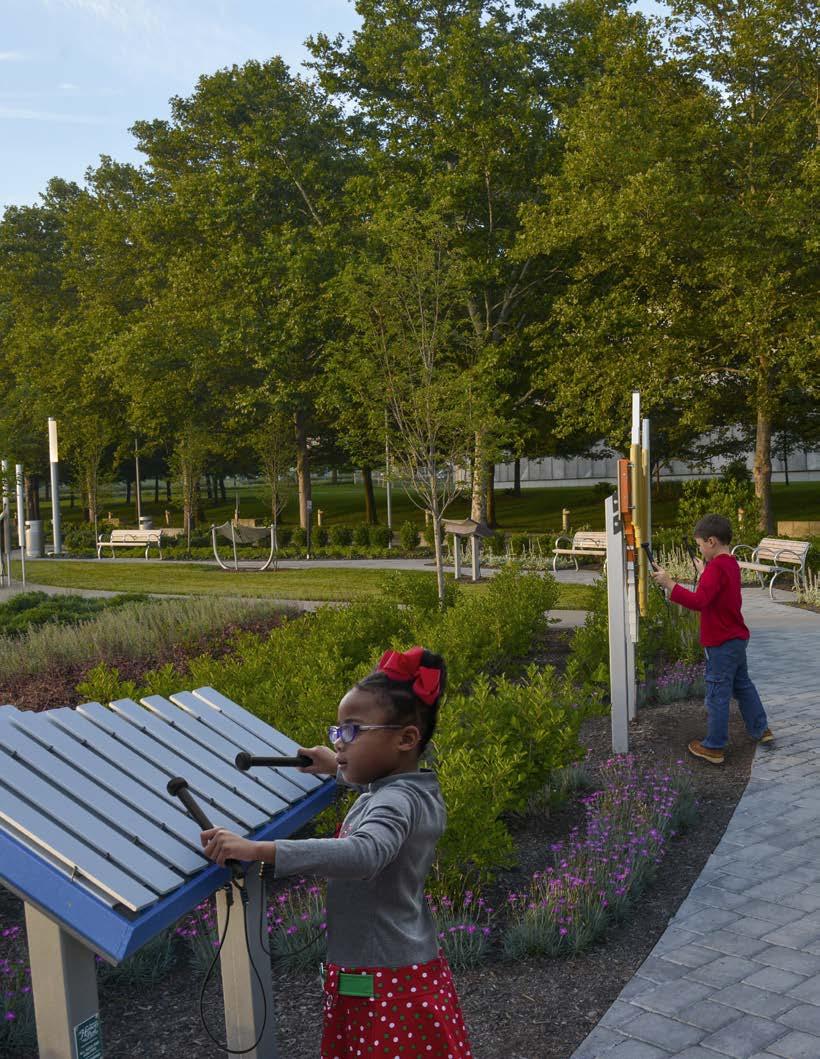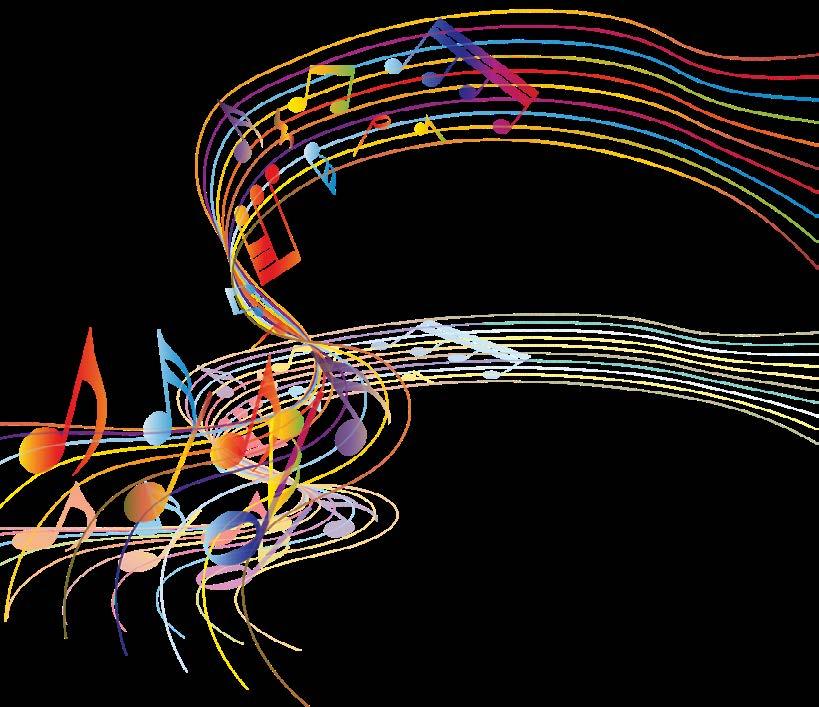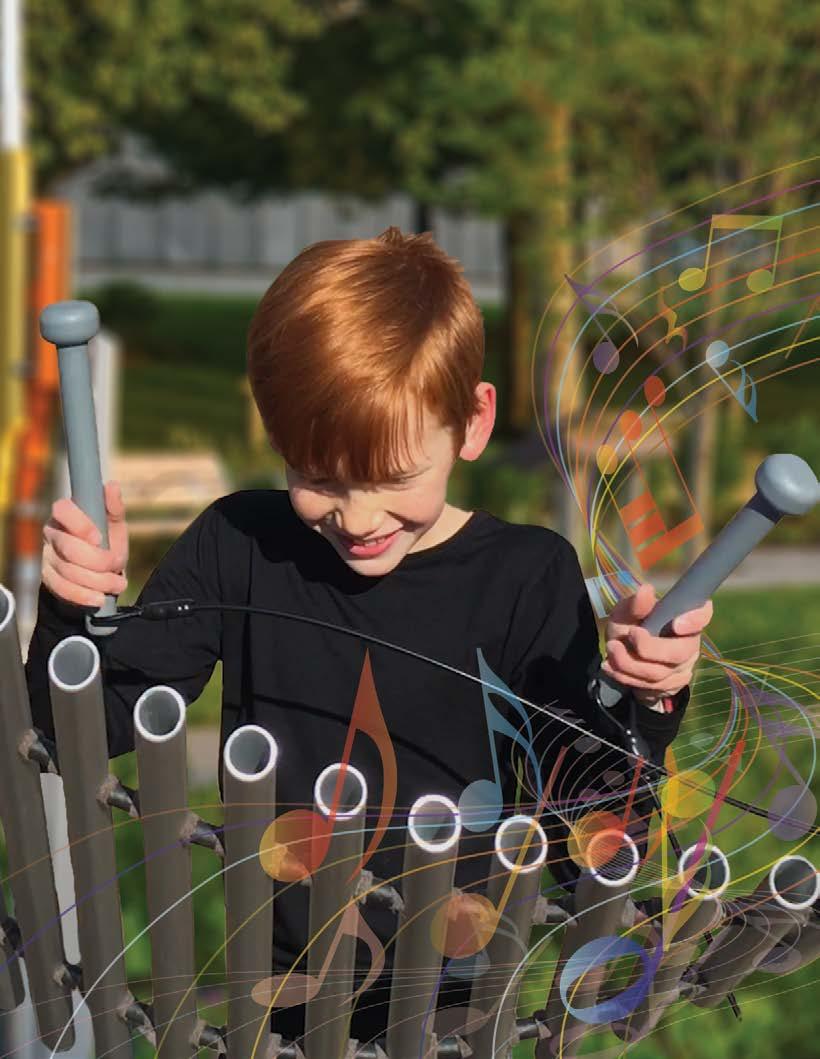

Natural Harmony
An Instrumental Guide to Blending Outdoor Music & Community ™
Partners

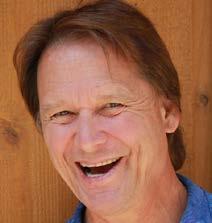 Melissa Hughes, PhD
Melissa Hughes, PhD
Dr. Hughes is the President and Founder of The Andrick Group and the author of “Happy Hour with Einstein.“ With deep roots in education, Melissa began her career as an elementary school teacher before teaching at the university level. That teaching experience inspired her to explore how the brain learns best and those factors which impact cognition and our capacity for creativity, communication, problem solving, overall success, and happiness. Melissa currently delivers professional development sessions and speaking engagements to organizations striving to build intellectual capacity, enhance employee engagement and communication, and inspire a culture of learning. Having worked with learners from the classroom to the boardroom, she connects brain-based research to practical applications that empower people to live smarter, happier lives.
Richard Cooke
Richard Cooke is a Grammy Award winning musician who has always been interested in teaching children and adults how to play music beyond formal training or even the ability to read music. As a child, he learned how to play the flute in an improvisational style without taking any formal lessons or having to read music. This experience inspired him to teach others how they might experience the freedom of playing music instinctively. He started designing outdoor musical instruments that allow everyone to become musicians with all the right notes and created the idea of having musical instruments in parks. For more than 20 years, he has been sharing the joy and freedom of playing music outdoors with children, their parents, siblings, and caregivers in multiple settings, including parks, gardens, schools, senior centers, and more. Richard shared his passion for music through a TedTalk at TEDx Mile High and continues today as an instrumental ambassador for the power of music.
Contributors
©2019 PlayCore Wisconsin, Inc.
All rights reserved.
The purpose of Natural Harmony™ is to provide an educational overview and considerations for incorporating outdoor music environments into a variety of settings across communities. This is not to be considered as an all-inclusive resource. Please refer to manufacturer specifications and safety warnings for all equipment. While our intent is to provide a general resources to encourage communities to include musical instruments as a recreational option, the authors, partners, program directors, and contributors disclaim any liability based on information contained in this publication. Site managers are responsible to inspect, maintain, repair, and manage site-specific elements. PlayCore and its brands provide these comments as a public service in the interest of building healthier communities through play and recreation, while advising of the restricted context in which it is shared.
Doug Schmitt, CEO, Schmitt Music
Camille C. Calderaro, MLA, ASLA, Fireflies Play Environments, Inc.
Kevin Snipes, Supervisor of Parks, Town of Fountain Hills, Fountain Hills, AZ
Dyane Sonier, Resource Development Manager, City of Rio Rancho, Rio Rancho, NM
Carrie Hanneke, Winter Park Resort, Winter Park, CO
David Olsen, Former Moab Community Development Director, Moab, UT
Richard L. Parrish, Charter Member, Director & Past President of the Minneapolis City of Lakes Rotary Club
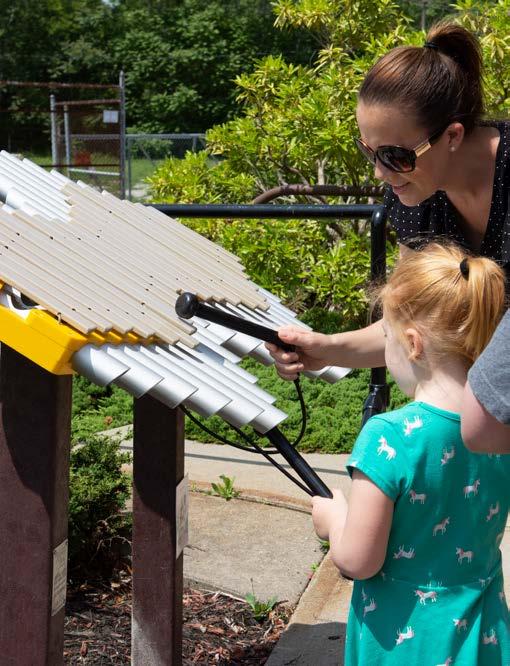
Executive Summary
A growing body of research confirms that experiencing music in nature positively engages the brain, builds social cohesion, and creates the conditions to build harmonious communities.
Music isn’t just an enjoyable activity; research shows how music has positive effects on learning, memory, and our ability to experience pleasure. It helps us grow as caring and connected individuals and enables us to build more harmonious communities.
We are also discovering similar psychological and physical effects from nature. Nature restores mental functioning in the brain the same way that water and food fuel our bodies. Like the muscles in the human body, the brain requires periods of rest and refueling. Specifically, neuroscientists have explored the impact of green spaces on the prefrontal cortex, or the command center for executive functions. Exposure to nature enables this region of the brain to slow down and recover from the constant stream of data and incoming stimuli. This is largely due to the visual elements found outdoors. The vast openness of the sky and the natural colors, textures, and sounds of trees, flowers, birds, and other wildlife, in stark contrast to the confines of the manmade world, are shown to reduce both stress and mental fatigue.
This rapidly growing body of research elucidating the physical, emotional, social, and cognitive benefits of both music and nature is comprehensive and compelling. While
we are still in the early stages of this research, we are learning more about the benefits of experiencing music in natural environments within communities. Natural music settings provide schools and other educational organizations with an effective way of incorporating learning and physical play opportunities, which are essential for healthy cognitive and emotional development. As we learn more about how music in nature affects our youngest and oldest citizens, the applications and benefits are proving to extend to everyone in between as well as the collective community. Ensuring a music space in nature is meaningfully designed is important to ensure the space is useful by diverse users, and that it invites collaboration in creative ways. Understanding how to plan appropriate settings, across a variety of locations offers benefits not just for those who play, but for people who participate as listeners, and even observers, as well-designed instruments provide an aesthetic, sculptural addition to the settings where they are placed.
In addition to site locations, the arrangement and type of instruments contribute greatly to people’s overall enjoyment. Instruments selected for their musical attributes, tonal quality, and the ability to create harmony within a given space, all contribute to their ability to connect people and create a joyful sense of belonging for players and listeners. Arranging them into meaningful groupings also helps provide musical integrity and optimize the experience.
To help encourage users and participants of all ages and abilities, consideration should also be given to site accessories. These amenities can further enhance the overall experience by providing information and comfort designed to extend the length of time the user spends engaged with the space.
Finally, providing adequate consideration to maintenance, though very little is required in a welldesigned outdoor music space, and considering ways to activate your space through programming and guided activities are important ways to extend the life of the space and promote usability.
In summary, experiencing music in outdoor settings promotes community engagement and greater individual happiness as it relaxes, soothes, and feeds the soul. Outdoor music spaces are a valid consideration in any community setting to provide users with an exciting, multigenerational way to engage.
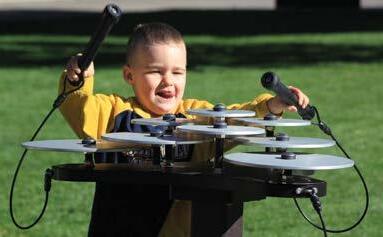
Perhaps nothing has been as fundamental to the shared human experience in every era and culture of the world throughout history as much as music.
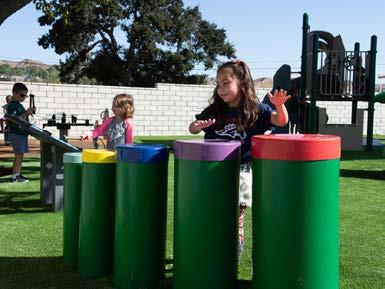
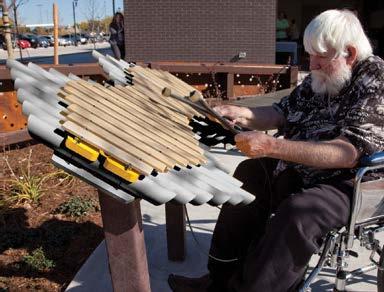
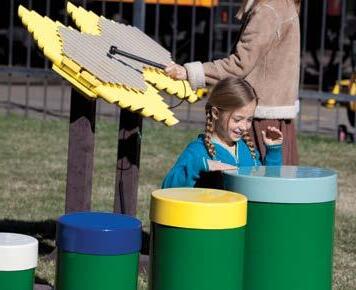
Anthropologists maintain that music is the original human language and that language has evolved from music.
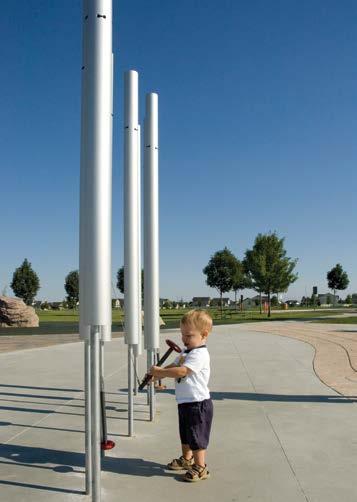
Why Music?
There is no art form more widely embraced by human beings than music. Music is an expressive language that connects people in a profound way. For most of us, music is woven through the fabric of the most significant and bonding experiences of our lives. Parents sing lullabies to soothe infants, marching bands play fight songs to excite fans, and church choirs lead congregations with music that feeds their spiritual souls. From birthdays to weddings to funerals, there is something about music that brings us closer together and strengthens the human bond.
Anthropologists maintain that music is the original human language and that language has evolved from music.1 The euphony of tones, harmonies, melodies, and lyrical compositions created the conditions for community, connection, and a sense of belonging.
In 2009, archaeologists unearthed the oldest musical instruments ever found. Flutes carved from bone and ivory were found in a German cave along with bones from bears and mammoths and flakes of flint in what they believe to be a Stone Age tool shop.2 The discovery that music was integral to prehistoric people who roamed the earth more than 35,000 years ago suggests that music is, indeed, a fundamental aspect of the human experience that transcends culture, language, and societal advancements.
For many years, music has been largely accepted as a “right brain task” where other artistic and creative activities take place. But now we know that music engages almost every part of the brain and strengthens the neural connections between the two hemispheres.3 Simply listening to music engages the auditory cortices as well as the memory center, language centers in both the temporal and frontal lobes, and the limbic system. The activity in the limbic system and the chemicals released are the brain’s response to emotions, memories, and feelings of overall well-being.4
Modern imaging technology such as functional Magnetic Resonance Imaging (fMRI) and Positron Emission Tomography (PET) scans show that musical rhythms can directly affect brain rhythms. What we feel at any given moment—whether we feel happy, sad, angry, or safe— depends upon our brain rhythms and music is powerful enough to change them.
In addition, reacting to music has been shown to have a direct correlation to affiliating with groups.5 Singing with others, for example, generates oxytocin, which enables us to connect with others and feel a sense of belonging.
Since the 1990s, or the “Decade of the Brain,” we have a wealth of research exploring the impact of music on overall well-being. The discovery of neuroplasticity, or the brain’s capacity to grow new brain cells and strengthen the connectivity between them, initiated this growing body of knowledge.
In addition, there is strong evidence substantiating the power of music on our health and the recovery time of hospital patients.6 Listening to music was shown to reduce stress, blood pressure, and postoperative trauma.
Also in the 1990s, a team of scientists in Italy discovered mirror neurons, or brain cells that respond equally when we perform an action and when we witness someone else perform the same action.7
Since then, additional research suggests that mirror neurons do not just explain the synchronization of neurotransmitters when we experience music with others, but it also explains more complex constructs such as empathy and altruism,8 as well as the evolution of language.9
These discoveries have not only illuminated the power of music on the physical, emotional, and mental health of the individual and social connectedness of the community, but they have significantly advanced our understanding of how human beings survive and thrive in a complex social world. Perhaps, nothing has been as fundamental to the shared human experience in every era and culture of the world throughout history as much as music.
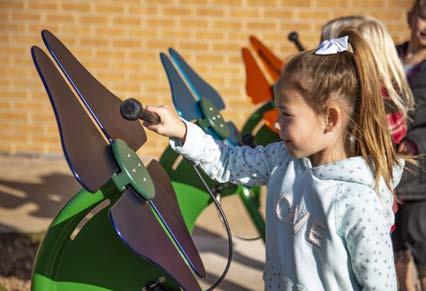
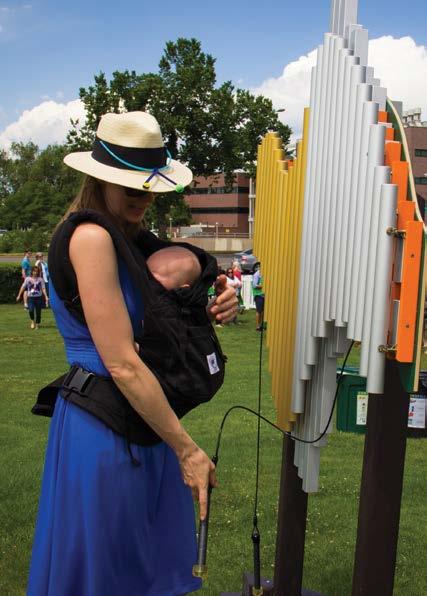
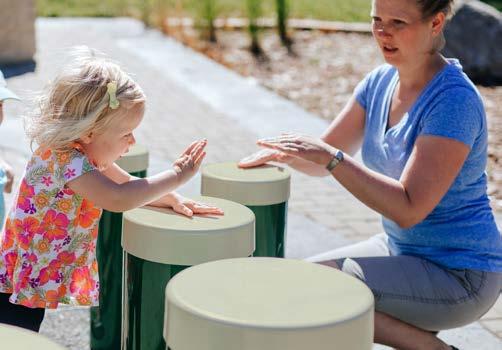
Combining music with nature has such a profound impact on us— not because science tells us so—but because of how it makes us feel.
Combining the Power of Music with Outdoor Environments
The power of music on our physical, mental, and emotional health as well as the social connectedness it nurtures cannot be overstated. The notion that music is medicine has roots that date back to tribal-based societies.10 Music also helps us grow as caring and connected individuals and enables us to build more harmonious communities. In addition, neuroscientists have also discovered similar psychological and physical effects from nature.11 Being outdoors or even just viewing natural scenes has proven to decrease cortisol levels in the brain (the neurotransmitter produced when we experience stress, anxiety, or fear) and increase the production of serotonin (which gives us a sense of calm and peace).12
Nature restores mental functioning in the brain the same way that water and food fuel our bodies. Like every other part of the human body, the brain requires periods of rest and refueling. Our cognitive capacity and ability to plan, organize, solve problems, and control impulses depends specifically on the prefrontal cortex or the command center for executive functions. Exposure to nature enables this region of the brain to slow down and recover from the constant stream of data and incoming stimuli. In addition, further research indicates that time spent in a natural environment reduces neural activity in an area of the brain linked to risk for mental illness. These findings suggest that natural areas may be vital for mental health in our rapidly urbanizing world.13
Extensive research over the last two decades demonstrates a correlation between an increased exposure to natural environments and positive physical, emotional, and cognitive benefits, like faster recovery time after injuries or medical procedures, higher academic achievement, and a reduction in crime and violent behaviors. Having the ability to measure the activity in the central nervous system, such as respiration, heart rate, and other physiological changes exhibited during stress, has proven that being outdoors is a calming agent on
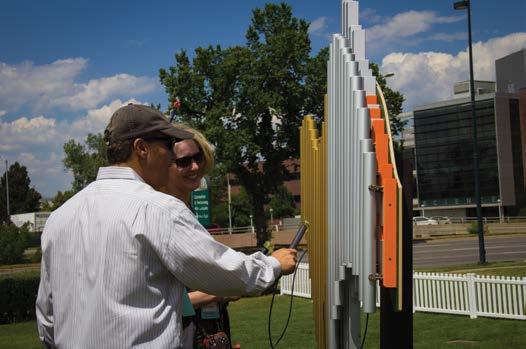
the mind and the body. Increased exposure to outdoor spaces also significantly affects both intrinsic and extrinsic aspirations such as nurturing relationships, making positive contributions to the community, or striving for a job promotion.14
Clearly, the physical, emotional, social, and cognitive benefits of music and of nature are comprehensive and compelling. Further exploration of the impact of music and nature combined is the obvious next step. While we are still in the early stages of this research, we are learning more about the benefits of experiencing music in outdoor spaces within various subsets of society. Outdoor music environments provide schools and other educational organizations with an effective way of incorporating learning and physical play opportunities essential for healthy cognitive and emotional development.
Combining music with nature has such a profound impact on us—not because science tells us so—but because of how it makes us feel. These two powerful forces extend the benefits from the individual to the community and make it possible for people of all ages, ethnicity, socioeconomic status, and ability to make music. There are no rules for the expressive art created in outdoor music spaces. Rather, it is simply an invitation to experience music and nature in a way that enriches, relaxes, soothes, and feeds the soul.
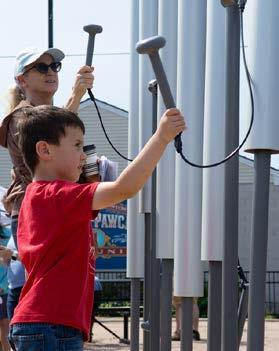
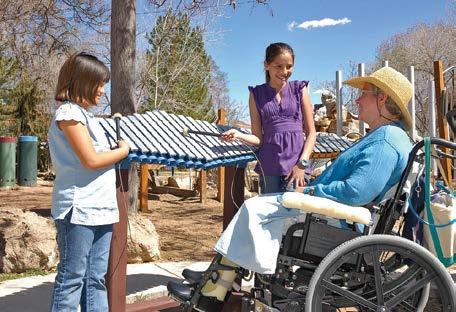
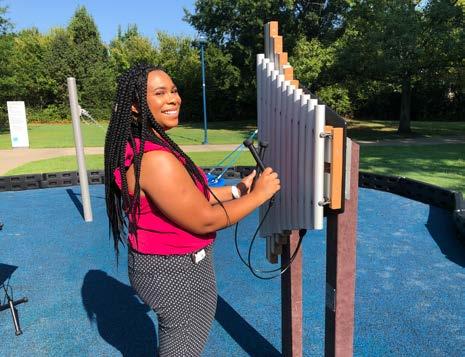
Brain-Based Research on the Positive Impact of Music on Individuals
Engaging the Whole Brain with Music
Until recently, we believed that people were born with a certain capacity for learning, and that intelligence and creativity were fixed traits. The “left brain/right brain” theory was also widely accepted as the explanation for why some people are more creative than others and some people are more analytical than others. Artists and musicians were right-brain dominant and had a much lower capacity for science and numbers. Conversely, scientists and mathematicians were left-brain dominant and had a much lower capacity for creative endeavors.
The capacity to learn, solve problems, and be creative is hardwired into our brains.
It is not the brain itself that determines our cognitive abilities, but rather the way it is trained and used.
We now know differently. The capacity to learn, solve problems, and be creative is hardwired into our brains. It is not the brain itself that determines our cognitive abilities, but rather the way it is trained and used. Technological advances enabling neuroscientists to view and understand brain activity have created a groundswell of research examining various factors that impact cognitive function and development. What we have learned from this wealth of scientific study is that the brain is like a muscle, for it can change and grow “stronger.” When we engage more regions of the brain simultaneously, we create the conditions necessary for deeper cognition, improved memory, and enhanced processing abilities. We have also discovered that the brain changes with prolonged or repeated experiences.
Music making is one of the most demanding cognitive and neural challenges for a person, requiring a complex coordination of multiple actions to hear, process, or produce sound. Various elements of music, such as rhythm, melody, pitch, tone, duration of notes, texture, etc., are processed in different circuits throughout the brain.
Auditory perception and motor actions that are required to produce sound when playing an instrument toggle back and forth between the auditory cortex and the cerebellum as well as other regions of the brain. Imagery created by music is analyzed in regions of the frontal lobe. Singing is dominant in the right temporal lobe, while the syntax of lyrics and the composition of music are primarily processed in the left temporal lobe. All our neural systems—motor, sensory, emotional, and analysis—are activated when we experience music through creation or enjoyment.15
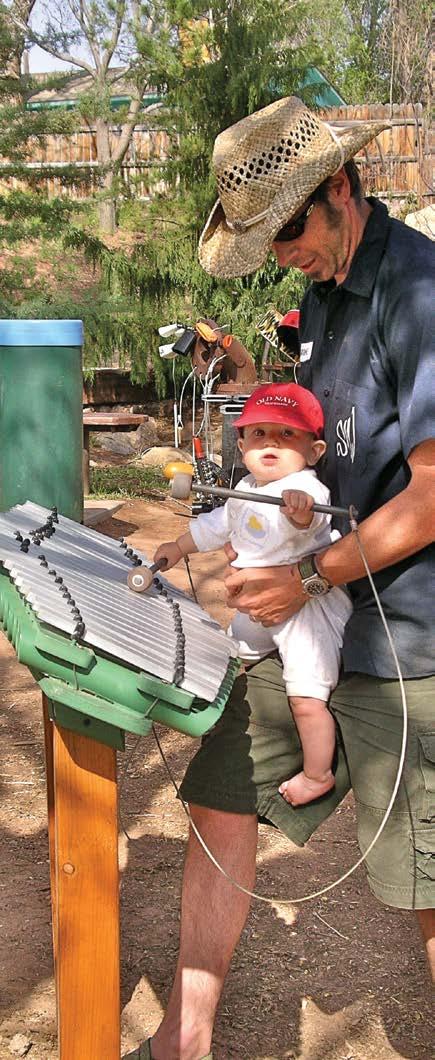
The act of experiencing music facilitates a broad range of healthy development, including cognitive, emotional, and social growth.

This whole-brain engagement ultimately strengthens the corpus callosum. When it comes to this particular brain region, size definitely matters. The corpus callosum is a thick bundle of nerves that connects the right hemisphere with the left hemisphere and allows brain regions with very different functions to work together. When it is strong and healthy, the corpus callosum enables the coordination of creative, scientific, mathematical, and linguistic processes and facilitates highly complex cognitive tasks. When it is underdeveloped or damaged— as in cases of autism, fetal alcohol syndrome, and traumatic brain injuries—the brain lacks the connectivity for even the simplest cognitive tasks.
Studying Albert Einstein
In 2013, a team of scientists examining Albert Einstein’s brain discovered that he had an unusually large corpus callosum. Even at his death at the age of 76, his corpus callosum was still a superhighway of connectivity. Neuroscientists believe that Einstein’s genius can largely be attributed to this connectivity, which activated his creative, scientific, and mathematical control centers simultaneously. While it is not known whether Einstein was born with a colossal corpus callosum or if it grew larger throughout his lifetime thanks to neuroplasticity, it is believed that this was the key to Einstein’s spatial and mathematical creativity. His brain also provided evidence of his lifelong love of playing the violin. Highresolution photos detailed a large “knob” on the primary motor cortex, the region of the brain that is activated with left-hand movements, which is probably the result of Einstein’s early and extensive training on the violin.16
Brain Waves
The human brain is made up of billions of neurons that communicate through electrical pulses. Our behavior, thoughts, emotions, and memories are the result of this neural communication. When the neurons and electrical pulses sync up, they create brain waves that are classified into five different types, each having a different frequency range. Gamma, beta, alpha, theta, and delta waves all have a specific purpose and each facilitates optimal brain function. For example, a teacher actively engaged in a lesson with her students would be generating beta waves. A leisurely walk in her garden after school would slow her brain waves down to alpha, and if she enjoys a deep, restful sleep at night, her brain waves would slow even more to delta.
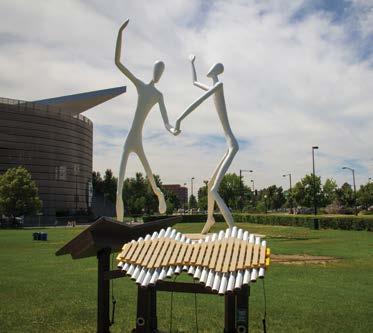
If you could actually view your brain waves in action as you went about your day, you would see all five types in use. Depending upon what you are trying to do—learn a new language, solve a brain teaser, or brainstorm the next big idea—one type will normally override the others, but they are all in there somewhere.
Ironically, as complex as the human brain is, its tendency to follow a rhythm makes it somewhat predictable and easy to manipulate. Neuroscientists have discovered that sound frequencies can alter brain wave activity. For example, when we listen to music with a fast tempo, our brain waves tend to speed up to mirror the frequency of the music we hear. When we listen to slower music, our brain waves naturally slow down. Think about how differently you feel in a nightclub versus a yoga class.
Neuroplasticity
In the 1990s scientists discovered the concept of neuroplasticity. Scientists use the term to describe the brain’s ability to adapt and change as a result of prolonged, repeated, or intense experiences. Since that time, there has been an explosion of research in labs all over the world, from scientists of varying disciplines, using a wide range of research methods to examine how experiencing music affects the nervous system. The multi-sensory nature of music stimulates neuroplasticity in an extraordinary way because of the multiple neural systems in action simultaneously. Overwhelmingly, the findings confirm that the plasticity of the brain and the changes in structure and neural connections made through extensive exposure to music also prime the brain for other cognitive tasks, including language, speech, memory, focus, and concentration.
Research into the neuroscience of music shows that musicians’ brains are better able to distinguish meaningful sensory information from noise. This ability primes their brains for complex cognitive tasks like language, speech, and memory as well as enhances neuroplasticity in various brain regions.
Actively Engaging with Music
An active engagement with music not only enhances neuroplasticity and strengthens neural connections, but it also primes the nervous system and influences overall health and emotional well-being. These benefits extend far beyond developing music appreciation, understanding musical theory, or just pure enjoyment. The act of experiencing music facilitates a broad range of physical development as well as cognitive, emotional, and social growth. Even infants demonstrate a neural response to pitch, melody, and other musical elements in songs played to them for several days. For example, premature babies have demonstrated significant physiological improvements, such as heart rate, oxygen saturation, and respiration rates, when exposed to music.17
A large and expanding body of research indicates that making music delivers even greater benefits than listening to music. For example, one study found that playing an instrument early in life can slow brain aging in senior citizens. Older people who had musical training when they were young could identify speech 20 percent faster than those with no previous training.18 In another study, preschoolers who learned how to play the keyboard performed better on spatial-temporal reasoning tests than their peers who received computer instruction or those who didn’t receive instruction in either activity.19 Elevated spatial-temporal reasoning is believed to result in higher math and science performance. From improving language skills to math-related reasoning, decision-making, emotional regulation, and slowing the aging process of the brain, scientists agree that making music enhances brain function.
Because the neuroplasticity effect of music is more pronounced in children, we have seen an explosion of research in recent years focusing on the impact of music training on education and our capacity to learn. For example, a recent study explored the plastic changes in the brains of children who received musical training compared to those who did not. They found that just two years of musical training in a child’s early years physically alters his brain. In addition, children who participate in formal musical training demonstrate better verbal memory, second language pronunciation accuracy, reading ability and executive functions. Learning to play an instrument as a child may even correlate to higher academic performance and IQ in young adulthood.20 When children are actively immersed in music— producing different dynamic sounds on pitch with an instrument in a rhythmic pattern—they develop permanent neural systems and structural changes in the auditory and motor regions that stay with them through life.
Over the last decade or so, neuroscientists exploring the impact of making music on the developing brains of children have identified six structural neural differences in the prefrontal cortex between musicians and non-musicians. The prefrontal cortex is the region of the brain responsible for executive function, decisionmaking, impulse control, and planning. Playing a musical instrument enhances the development of this brain region in the early years, which transfers to significantly greater academic growth across all school subjects. A recent meta-analysis of 15 studies found a “strong and reliable” correlation between musical training and intellectual development as measured by standardized test gains and significant increases in IQ. The longer the students played musical instruments, the higher the gains.21 This is supported by a wealth of research that shows actively experiencing music activates the brain regions responsible for memory, focus, and concentration.
Language and literacy skills are also enriched with music because they share a number of processing systems in the brain. Active engagement with music impacts early encoding of linguistic sounds, which also impacts reading skills. In addition, musical training shares the same neural processing
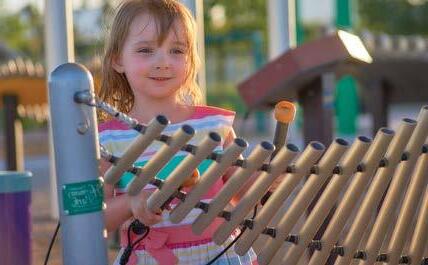
Overwhelmingly, the science is unequivocal: music stimulates the brain in a way that facilitates the cognitive function and neural connectivity necessary for healthy intellectual, social, and physical development. This collective conclusion is accompanied by one very important caveat: for children to fully reap the benefits of music, they must have ample opportunities to engage actively in the music.
systems that impact phonemic awareness and speech processing. Intervention studies have shown that children who struggle with reading, pattern recognition, and auditory attention have benefited significantly from musical training. Similar to sports training, children can develop enhanced motor skills by playing musical instruments.22
Active engagement with music has also been linked to an increase in emotional sensitivity and emotional intelligence, more positive attitudes towards school, better attendance, increased self-confidence and persistence in overcoming frustrations when faced with challenges or obstacles, and greater intrinsic motivation for learning.23

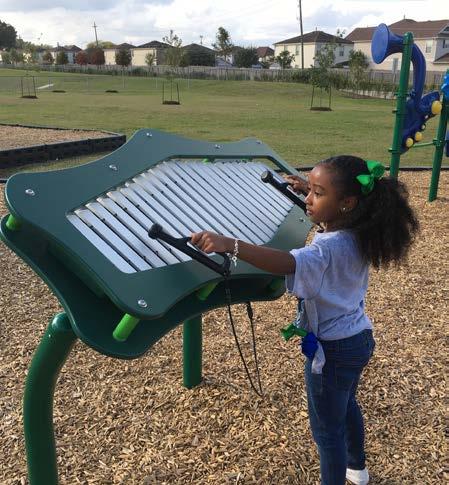
“The more I live the life of music, the more I am convinced that it is the freely imaginative mind that is at the core of all vital music making and music listening.”
-Aaron Copeland, American Composer
Benefits of Music on the Family
Tapping to a drummer’s beat, twirling to music, singing a favorite song— musical experiences add richness to life for children and adults alike. How families engage in music can vary depending on the ages of the children. For them, everyday music activities might be singing lullabies to babies, dancing to tunes on the radio, or playing instruments together. These shared emotional experiences build stronger social closeness between caregivers and children.
As a mother sings to her baby, her soothing melodious voice tends to calm the child. For anyone who has observed this, it may raise the question: Is it the singing or the familiar movements of the caregiver that the baby is responding to? A wealth of research strongly indicates that people are wired for music but, does this connection happen in the early months of life? Researchers at the International Laboratory of the Brain, Music, and Sound in Montreal, Canada, have investigated how infants respond to music. A study was set up with 7-to-10-month-old babies to find out what engaged their attention. The researchers had the infants listen to singing and speaking delivered in a happy, rhythmic tone, commonly known as baby talk. However, the recorded voices were not speaking in the child’s native language. What Mariève Corbeil, Sandra Trehub, and Isabella Peretz observed is fascinating. The researchers observed how the music audio held the baby’s attention longer than the speaking audio; the time was about twice as long, according to Corbeil.27 Other studies indicate that 5-month-old babies can move rhythmically to a strong beat in music but not irregular beats.24 The sing-song rhythmic pattern of baby talk engages an infant’s attention; it sounds more musical than normal speech.
The musical experiences in families change as children become older. Whether it is listening or dancing to lively music or singing along with a favorite tune on the car radio, enjoying these kinds of activities with a family member strengthens important relationship bonds. Toddlers easily dance, clap, or march to a strong beat and enjoy doing this with a caregiver. As children move through the preschool and elementary school years, their interest in music remains strong even though the way they are engaged by music may have changed—improvised singing, rhythmic chanting, dancing, playing instruments, and singing along with others. When parents play their favorite kinds of music, it can spark conversations about those selections with their children. These everyday musical experiences in families connect children and caregivers in special ways and foster stronger communication. This family bonding through music does not stop when children become middle school age or older. One study has found that there are positive emotional effects

in families when interests in music are shared between parents, teenagers, and young adult family members.25
It is well established that parents are a child’s first and most important teacher. The positive messages that parents tell their children while exploring “music making” are beneficial. Musical free play starts when toddlers strike surfaces, such as the floor or another object, with whatever is being held in their hands in a steady tempo. It may match the beat of a song that parents are singing or the recorded music playing in the background. Musical free play could also be happening as young children dance to engaging instrumental music, creating soft sounds with shakers. Their infectious smiles spread to those who are watching nearby.
These opportunities for child-initiated musical free play continue to flourish as preschoolers investigate instruments, such as drums, keyboards, or xylophones, at home or in school settings. As children gain sharper listening skills, they may observe differences in generated sounds, such as with collection of drums that differ in size and the sound produced when tapped. One case study noted how a preschooler arranged several drums in line by pitch from highest to lowest sound. Even though the first sounds produced by another young child on a ukulele were not conventional, the spontaneity of free play carried that child’s interest into further investigations. Researchers in this case study also noted how important it is for children to control their participation in free play. When children received encouragement from their parents, they continued to develop a meaningful relationship with music through investigation without specific guidance.26 The wonder and enjoyment in making music that children experience from free play can be facilitated in a home and/or music environments. Active engagement with music helps stimulate the imagination. The American composer, Aaron Copeland wrote, “The more I live the life of music, the more I am convinced that it is the freely imaginative mind that is at the core of all vital music making and music listening.” The bud of musical creativity can start to form in the preschool years and continue blossoming in the elementary school years as children have new musical experiences and make their own music, supported by their parents’ encouragement.
One study by Suzanne Burton, PhD at the University of Delaware, investigated the growth of musical thought
in preschool age children by observing how children manipulated musical elements in their spontaneous songs and chants. No conclusions were drawn from the study but it does highlight how children were “processing music and information from their environment.”27 Keeping kids actively engaged with music might be a challenge for parents but the rewards in stimulating the brain are significant as has been noted in research. Parental guidance is essential in helping children enjoy making music and fostering flexibility in thinking. When children are interested in learning how to play an instrument, the support of parents makes a difference. Whether it is learning how to play a favorite music genre that fuels the imagination, improvising musical rhythms on percussion instruments to accompany songs, or creating original music works, all engage a child’s mind.
The positive dynamic of family support in a child’s development makes a difference. All of the evidence supports how active engagement with music not only strengthens parent-child relationships, but it also affects personal emotions, sparks imagination, and creates many wonderful memories.
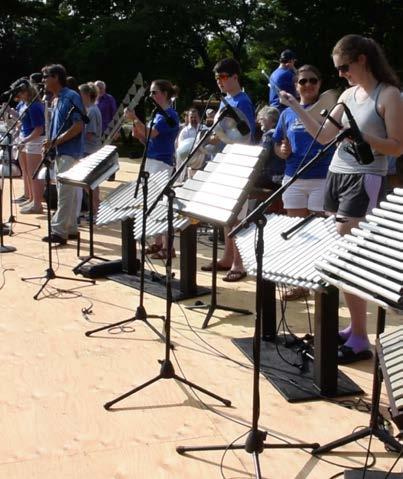
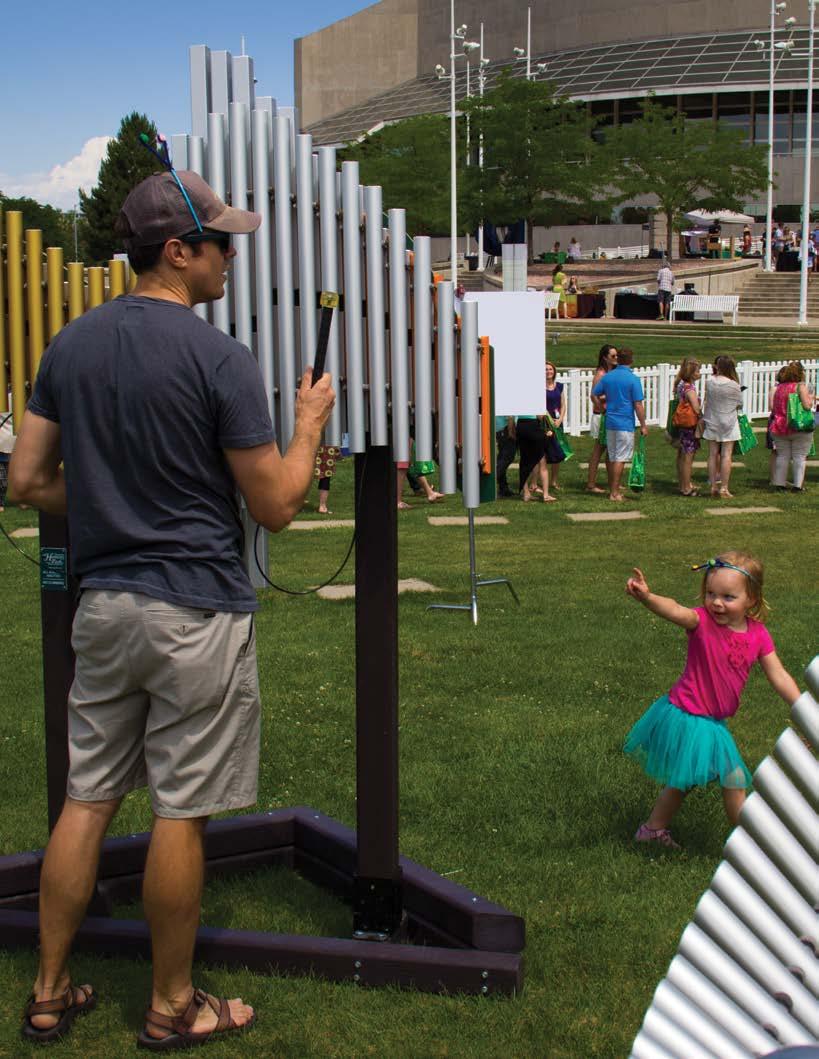


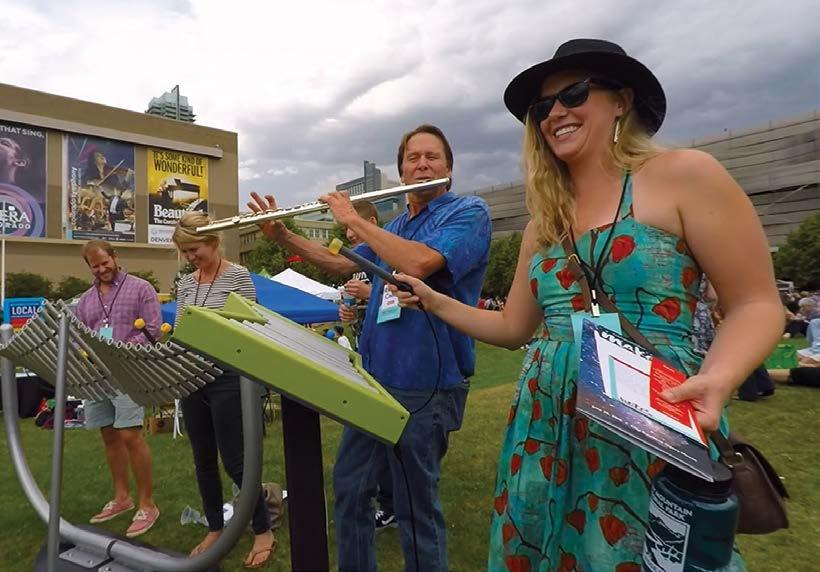
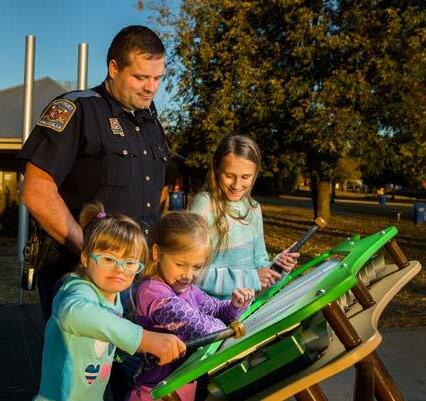
The power of music cannot be denied. There is ample evidence of how music adds vibrancy to communities, engages the brain, strengthens the sense of belonging and connection with others.

Benefits of Music on Communities
The Value of Amateur Music-making in the Community
For people who love music and enjoy performing for a live audience in their spare time, there are many positive benefits. Amateur musicians find that the hours of performance rehearsals, whether alone or with others, feel like leisure activities—an enjoyable, artistic experience with intrinsic value. Even though their rehearsals may be rigorous as they work on technical accuracy and perfect the quality of sound and transmission of feeling through the music, it is not viewed as work.28
The depth of musical talent found in a community adds to the fabric of life for those living there. Highlyskilled amateur musicians seek ways to share their musical passion with others, such as performing on the stage, in the orchestra pit for summer musical theatre productions, entertaining audiences in coffeehouses, performing on street corners or in outdoor band shells, or singing in auditoriums. These venues are vehicles for different music genres. Many communities have vibrant music scenes and, possibly, distinctive musical styles. Music genres differ in tonal harmonies, texture, rhythmic patterns, and delivery. The list of music genres is extensive; musical styles range in popularity from rock to hip-hop to country to Latin, and so on. Other categories cover bluegrass, blues, jazz, pop, classical, choral, and gospel music. The uplifting musical experiences that are shared through the blending of vocal or instrumental “voices” create bonds with listening audiences and boost community pride.
The Impact of Ensemble Musical Experiences
Singing with others, playing instruments in a group — the richness of shared musical experiences — also enable new friendships to form. One study found that singing together in choirs might have an “ice breaker” effect on participants, providing a faster path to new social
connections than in other social situations.29 Special bonds that form as singers blend their voices with others to create beautiful music can be very uplifting. Likewise, the hidden benefits become evident as singers forge friendships with others whose backgrounds and life experiences are very different.
From well-supported research findings, scientists know that the brain is altered in intricate, positive ways when musicians—amateurs and professionals—actively participate in making music. The musical avenue for those who play instruments is actually quite broad. Musicians from preteens to senior adults can be involved in vibrant groups. Depending on their age, technical skill levels, and musical preferences, the groups that instrumentalists can join range in size from a few participants to very large ensembles, such as quartets, jazz bands, school bands, community bands, orchestras, drum and bugle corps, and marching bands. When taking a closer look at the intrinsic value of participating in a high school marching band, it can be noted that these experiences yield valuable character-building lessons for youth. Students learn about the importance of teamwork, shared responsibility, and self-discipline, while gaining strong time management and sharp observation skills. Rehearsals can be strenuous and weather conditions can be unpleasant, yet determination makes the difference in what can be accomplished. Resilience is evident as band members bounce back from mistakes to achieve perfection. Great satisfaction is felt when band members as a team accomplish artistic beauty in the flawless playing of intricate music and creation of flowing, complex designs that change through marching in time with the music.
For those who learned how to play a musical instrument in their youth, there may be more benefits than just experiencing the pleasure of making music. Brenda Hanna-Pladdy and Alicia McKay, researchers at University of Kansas Medical Center studied the effects of music instruction during childhood years on the cognitive abilities of healthy adults, ages 60–83. The participants were grouped according to their music-
making experiences. Aside from the control group of nonmusicians, the participants in the study started learning how to play a musical instrument around 10 years of age. The researchers discovered that the participants who played an instrument for at least 10 years performed significantly better on the battery of cognitive tests than the other participants in the study.30
The Positive Effects of Music Intervention Programs in Communities
The field of research has been expanding as scientists look for ways music can be used as an intervention tool. One particular area of interest is the impact of music education on the achievement gap between students from low-income families and those from affluent families. Dr. Nina Kraus, a neuroscientist and director of Northwestern University’s Auditory Neuroscience Laboratory in Evanston, IL, is facilitating long-term studies to find out what impact schooland community-based music training has on the academic accomplishments of at-risk children. In 2014, she and her team of colleagues started conducting a randomized, controlled study of the long-term neurological benefits on students enrolled in The Harmony Project, which was founded by Margaret Martin in Los Angeles, CA. Through this program, started in 2001, students from low-income families who have not had any music education are enrolled in tuition-free weekly music classes and ensemble rehearsals that are led by professional musicians and held yearround. The success rate of this program is commendable. The Harmony Project now works with over 2,000 students annually from low-income communities. Since 2008, ninety percent of the high school seniors enrolled in this project for at least three years pursue further education. Not only is that a tremendous success, but the findings from the research point out how younger students who played an instrument for two years in The Harmony Project showed higher gains in reading scores and communication skills than their peers who were less involved.31
Another area of study for neurologists is how listening to music affects the brains of adults with neurological disorders. The results are fascinating as neuroscientists share their findings on the impact of music on brain injuries and brain conditions. One study investigated the musical processing abilities of people with epilepsy. Researchers noted a higher degree of synchronized activity in the temporal lobe of the brains of those who had a neurological disorder when listening to recorded music than what was experienced by those not listening to music.32
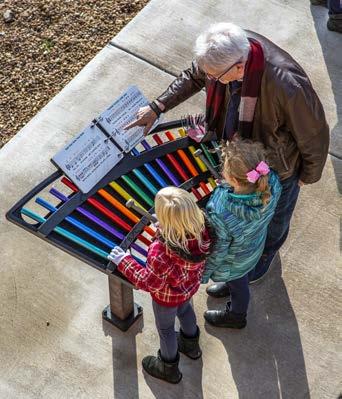
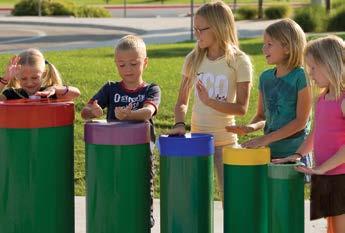
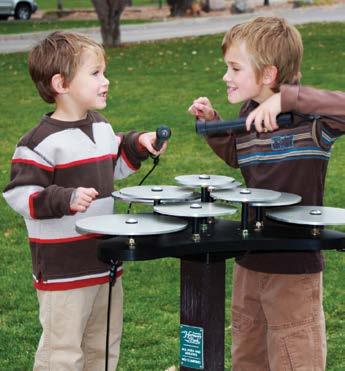


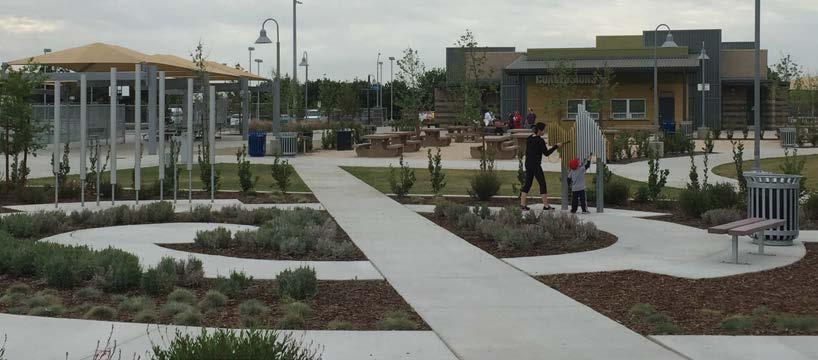
Moving beyond the research findings of how music affects the brain, some scientists are now interested in knowing if music participation also has an impact on the physical and emotional well-being of older adults. Julene Johnson, PhD. conducted a study in Finland and found that elderly adults who sang in a choir experienced positive effects on their health.33 Dr. Johnson’s continued interest in this topic has also been sparked by the research conducted by the late geriatric psychiatrist, Dr. Gene Cohen. His findings noted very positive physical and emotional health benefits for older adults who participated in community arts programs. As lead researcher, Dr. Johnson has set up a new study on the potential benefits of music participation for older adults in the San Francisco, CA area. Extending over a five-year period, her research focuses on the cognitive impact and overall physical and emotional well-being of adults 60 years of age or older who sing in the Community of Voices choirs.34 Even though it is widely known that singers enjoy being a part of a music community, scientists continue researching to find out if singing with peers supports healthy aging.
The power of music cannot be denied. There is ample evidence of how music adds vibrancy to communities, engages the brain, strengthens the sense of belonging and connection with others, and possibly boosts the physical and emotional health of older adult participants.
Meeting the Needs of Diverse Users
Music engages the senses, ignites creativity and imagination, and spurs meaningful interactions between users. Outdoor music environments uniquely bring
together diverse user groups to spontaneously interact, socialize, collaborate, create, and learn from each other. Music can lure people of all ages and cultures—children and youth, adults, seniors, families, community groups, learning communities, and the like. People of all ages and abilities can play together effortlessly. Well-designed outdoor musical instruments have complementary scales to encourage creative exploration and offer interesting tactile play.
Whether the Instruments are explored independently or collectively through interactive games and social play, users are engaged musically. Children and adults enjoy the self-directed play. The instruments can be used to facilitate deeper levels of engagement with peers and shared experiences of joyful harmony. These diverse musical opportunities help children of all ages develop a sense of wonder, comfort, and confidence in their movements. They also lead to improved self-esteem, increased communication and cooperative play, and positive reciprocal interactions. Thoughtfully planned and well-executed outdoor music environments benefit the whole community.
The evidence is profound: making music is beneficial for children, families, and communities, and the outdoor environment is the ideal location. Multigenerational users can collaborate in these musical spaces in interesting and creative ways. A well-designed outdoor music environment services diverse users, accentuates natural attributes of the outdoor setting, and provides intentionally harmonizing musical elements that facilitate discovery and bring joy to every experience.
Planning & Design Considerations for Outdoor Musical Environments
Ideal Musical Settings Are Everywhere
Planning the appropriate settings for outdoor music spaces across a community is just as important as understanding their many benefits. Historically, municipalities and progressive parks and recreation departments have taken the initiative to design and implement music parks in their public areas, sometimes adjacent to playgrounds, trails, and gardens. These departments often understand the need for a variety of outdoor experiences and activities to offer their constituency. Most parks and recreation departments provide thriving outdoor spaces for individuals, families, and communities to enjoy, including trails, playgrounds, dog parks, recreation centers, and more. Outdoor music areas are the perfect addition to these diverse community public spaces.
Beyond parks and recreation departments, outdoor musical spaces can be found in a variety of locations. Many schools, early childhood centers, arts and cultural centers, hospitals and rehabilitation clinics, active living communities, military bases, and even senior centers have been adding outdoor music environments to provide unique and attractive socialization opportunities. Hospitality (including resorts, hotels, motels) and destination locations (amusement parks, children’s museums, and civic centers) are also incorporating music parks across their properties for distinctive experiences that engage and entertain their visitors. Likewise, city centers and town squares are installing music spaces to activate their community in new and innovative ways. With a little creativity and planning, the medium of music can be a wonderful multisensory enhancement to virtually any setting.
Thus, community advocates, managers, and officials across a variety of settings and locations are realizing the positive impact outdoor music environments can have. Not only are they beneficial for those playing the instruments, but they also offer benefits for those listening.
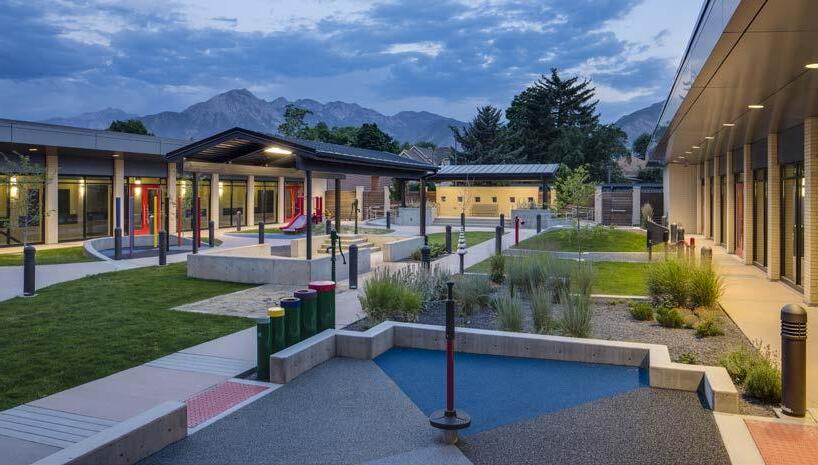
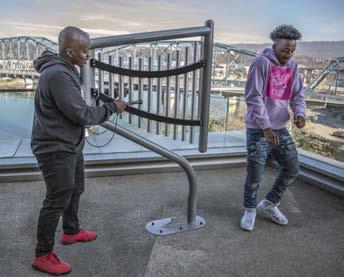
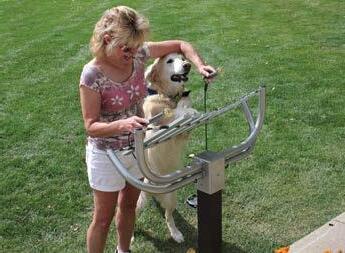
Outdoor musical environments are often integrated into areas already offering play and recreational experiences, but they can also be instrumental in activating a variety of other locations that have open or underutilized space:
• Public Parks
• Schools
• Early Childhood Centers
• Playgrounds
• Trails
• Gardens
• Dog Parks
• Recreation Centers
• Art Centers
• Hospitals
• Rehabilitation Clinics
• Military Bases
• Senior Centers
• Hospitality Settings
• Amusement Parks
• Museums
• Civic Centers
• Libraries
• City Centers
• Airports
Unique Features and Benefits of Outdoor Music Environments
In addition to the myriad of developmental benefits that outdoor musical spaces afford to the players, they also build pride and foster social connections across a community. These engaging outdoor environments are useable by all people. Outdoor musical instruments are uniquely designed for improving human performance, as they inherently ensure musical success from the very first note. The individual instruments and ensembles help users create music even if they have no musical expertise. These unique, creative play experiences positively connect people, fostering a sense of joyful belonging for both players and listeners. One of the greatest strengths of these music spaces is the way they bridge the gap between individuals of varying ages, abilities, socioeconomic backgrounds, and ethnicity, thereby reducing isolation and social stigma.
Outdoor musical instruments also serve double duty as they provide amazing functional experiences for the users while creating beautiful sculptural additions to any outdoor space. Cleverly designed groupings of instruments can help bring vitality and interest to a space and can also help promote a community’s placemaking goals. Large outdoor music destinations with a robust assortment of instruments can draw crowds and promote collaboration while smaller ensembles throughout a community can spark new interest and activity within a location. Combining a variety of installations, large and small, can further broaden community connectivity and inspire diverse experiences that surprise and delight community members and visitors.
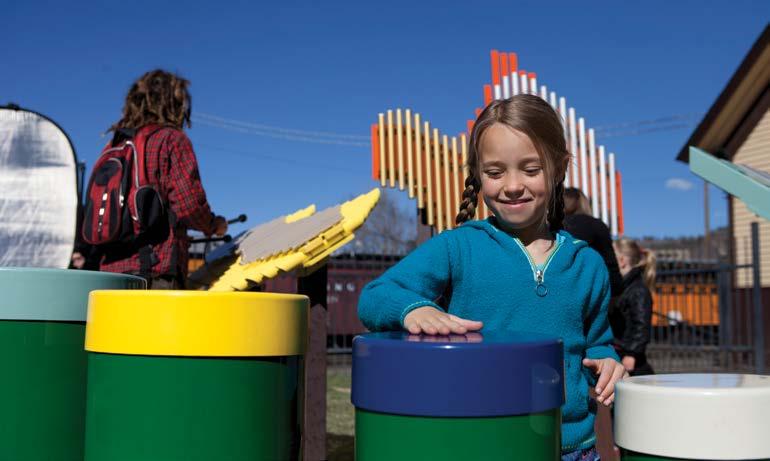
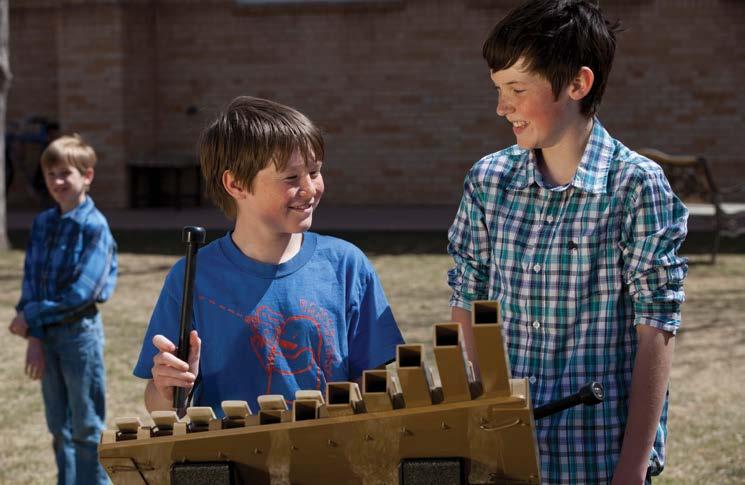
“Music imprints itself on the brain deeper than any other human experience. Music evokes emotion and emotion can bring with it memory. Music brings back the feeling of life when nothing else can.”
-Dr. Oliver Sacks
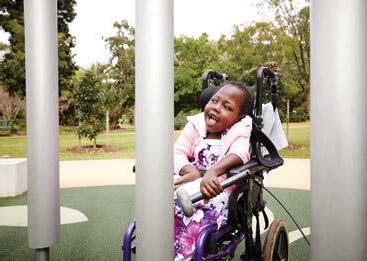
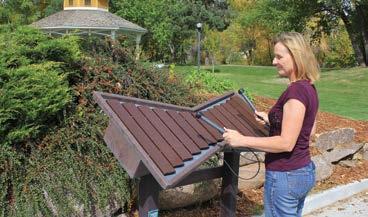
Selecting High Quality Instruments
For optimal musical expression, consider the size of your location and then select individual instruments based on their musical attributes and the ability to create harmony in that space. Knowing the tonal attributes of various outdoor instruments can help you get started and can guide your selection to ensure a good variety of musical sounds.
First, consider the length of tone that can be produced. Some instruments are percussive and therefore have a short length of tone, approximately one second. Others can be more sustaining, producing sounds that can last up to five or more seconds when struck. Both of these types of instruments can be successfully combined in a grouping to offer variety and interest.
Another sound quality to consider is the pitch range. This refers to tones that are low (bass), mid-range (alto), or high (soprano). Grouping the instruments in this way also helps to create more melodic interest. Some instruments are resonated—using acoustical (not electronic) air cavities to produce a fuller reverberating sound—which creates a beautiful, long, sustaining sound that can be heard and felt.
Selecting instruments that are in the pentatonic scale allows the music park to sound beautiful and interesting. Pentatonic harmonies are gentle and soothing. They include a five-note music scale within one octave with no semitones. The nature of the pentatonic scale means that it is impossible to make any real harmonic mistakes. A scale refers to the musical notes arranged by fundamental frequency or pitch. A scale organized by increasing pitch is an ascending scale while a scale ordered by decreasing pitch is a descending scale. In addition, including diatonic instruments (which use the C major scale, better known as the white notes on the piano) will even further enhance the harmonizing sounds that are created.
To enhance the texture of sounds produced, it is beneficial to select instruments from various categories, such as bells, drums, chimes, xylophones, and marimbas. Each category adds unique sounds, augments the overall musical harmony, and helps to ensure a richness of tactile and social experiences when in play. Within each category, there are a variety of options. Bells include cymbals in various pitches. Drums can come in several different sizes, heights, and tones. Chimes can include bass, soprano, and alto/soprano pitches. Xylophones, which resonate like a gong, are in the A or C scale and can offer ergonometric and accessible mallets to meet the diverse physical needs of users. Marimbas uniquely combine the features of a xylophone and a kalimba (also known as a thumb piano).
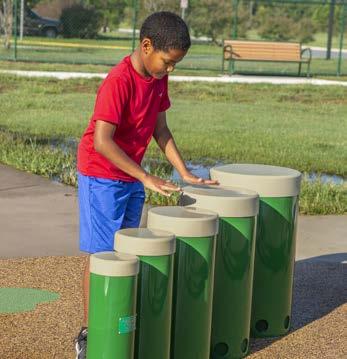
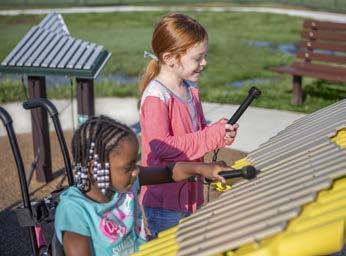
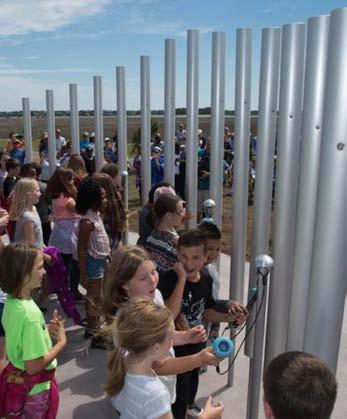



Understanding the unique features and benefits of instruments will help ensure harmony to optimize musical expression.
Grouping Instruments to Create Meaningful Ensembles
Selecting high-quality groupings of instruments is an important part of the planning process to help provide musical integrity and optimize the musical experience. Prioritization should be based on the variety of sound quality and pitch range, budget, and space availability. Instruments offer unique and intentional sounds (soprano, alto, bass), and a good variety of categories can provide unique playing experiences by mixing chimes, bells, drums, marimbas, and xylophones appropriately in an area.
Selecting sounds that are sophisticated allows everyone from novice to expert musician to be engaged. A basic grouping of instruments including xylophones, chimes, and marimbas are preferred as they allow even the most inexperienced player to send beautiful notes into the world. Clustering three to six instruments helps increase the time people spend playing the instruments. A good rule of thumb is to select a group of instruments that include a soprano instrument, an alto instrument, a bass instrument, and drums as they can be the most popular activity in an outdoor music environment. Consider the following ensemble suggestions as you begin your planning process:
3-Piece Ensemble
If the space for a music park is small, a 3-piece ensemble may be ideal due to its compact nature. This starter ensemble can intentionally feature percussion sounds on drums, soprano/alto sounds of aluminum keys and wood-like sounds of the fiberglass keys on an alto/soprano marimba and xylophone combination, and a bass xylophone for added versatility. These instruments should be arranged in equal distances along a 10-foot diameter. Bass/alto/soprano drums may be arranged in an arc, wave, or even a straight line to add interest to the park and provide interaction among musicians.
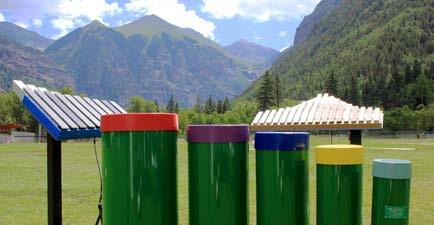
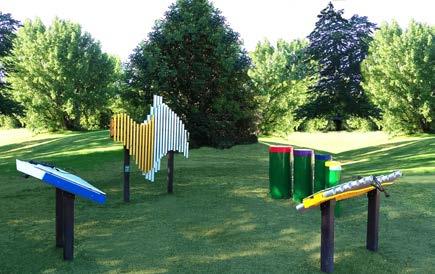
4-Piece Ensemble
Another possible configuration includes a 4-piece ensemble. This arrangement of instruments consists of alto/soprano chimes, an alto/soprano marimba, a bass xylophone, and drums. Designed to deliver a variety of sound qualities and pitch ranges, the instruments may be arranged along a 12-foot diameter and equally spaced at 90 degrees to provide interactivity and socialization among the players while the bass/alto/soprano drums may be arranged in an arc, wave, or straight-line configuration.
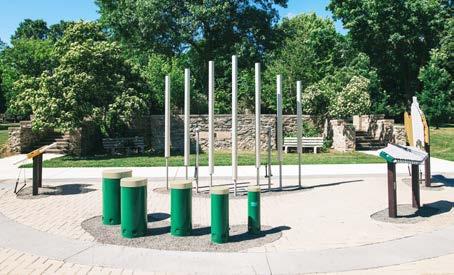
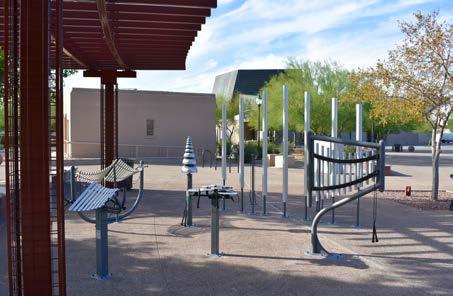
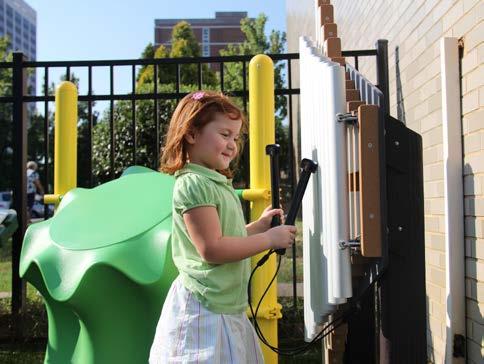




5-Piece Ensemble
A 5-piece ensemble allows players to step right into improvisational, solo, or group musical interactions. This ensemble of musical instruments delivers maximum pitch range with texture and pure distinct tones that blend into soothing sounds. The instruments can be arranged along a 16-foot diameter and can be equally spaced to provide interaction amongst players. The bass/alto/soprano drums and bass chimes may be arranged in a variety of patterns, including in an arc, wave, and straight line.
6-Piece Ensemble
A 6-piece ensemble is ideal for adding a sculpturelike feel and aesthetic appeal to the outdoor music space. This ensemble can include a beautiful grouping of both resonated and non-resonated instruments. The instruments can be arranged along a 16-foot diameter and equally spaced with alto/ soprano chimes, alto/soprano bells, an alto/soprano xylophone, alto/soprano/bass bells, soprano chimes, and bass chimes. Placing the collection in a circle allows players to interact with each other and feel like they are part of an orchestra.
Specialized Ensemble
Tailoring specialized ensembles for specific user groups can also create meaningful experiences. Early childhood ensembles can be configured using half-size instruments with aluminum resonators replacing the alto/bass/soprano design. They occupy less space and require smaller budgets, making them attractive on many levels. Surprisingly delightful for young children, these interactive and artistic arrangements also work as educational tools to challenge the imagination by stimulating creativity. An ideal early childhood ensemble can include alto/ soprano chimes, an alto/soprano marimba, and an alto/soprano xylophone. Arrangements can be placed along an 8-foot diameter in equal distances to maximize access and flow as users move from one instrument to another.
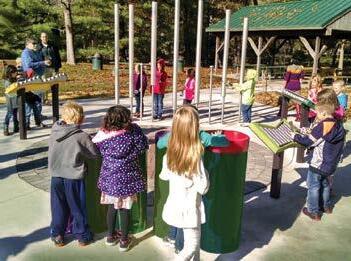
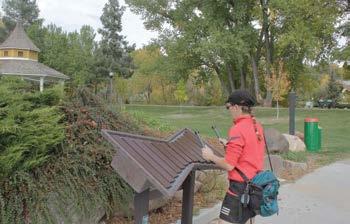
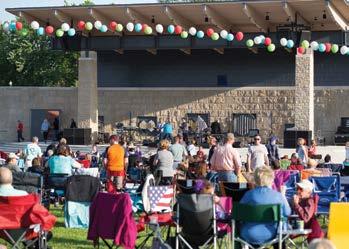
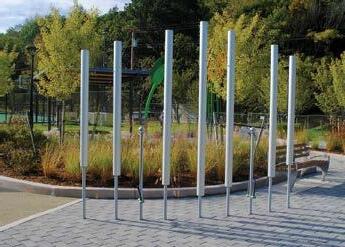
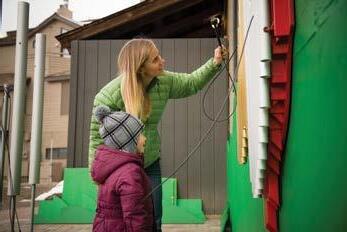
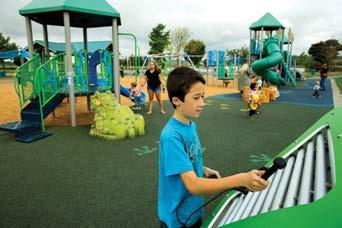
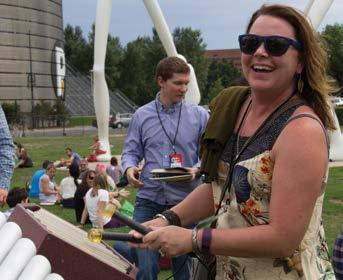
Designing Meaningful Musical Typologies
While selecting the instrument variety has a direct impact on the quality of sounds users can create and experience; placement, and location of the groupings is also critical for enhancing the user experience and increasing the interactions amongst players. The arrangements can be designed in a variety of ways to capture the benefits of the local typology, site dimension, and goals of the project. Some arrangements encourage the outdoor music park to become gathering destinations while others can encourage movement and exploration. Good design carefully considers the site context and goals for the user experience.
Signature Destinations
Clustering instruments together as an intentional destination is a very successful design strategy. It is most useful to arrange instruments in a way that the players can have good eye contact, versus having their backs to one another. Depending on the site dimensions, a circle, square, or triangle are preferred grouping shapes. This encourages interactive and cooperative play, where the players can read expressions, share delight, and respond to one another. When creating a park ensemble, accessibility through the instruments works best when they are placed at least 4 feet apart and installed at optimal reach heights and angles.
Linear Pathway Networks
Creating interesting musical experiences along pathways and trail systems is another viable strategy for encouraging community connectivity, exploration, and movement, all while discovering the joy of creating music along the way.
Performance Venues
Intentionally designing music clusters on stages and/or amphitheaters can spur imaginations and invite both programmed and spontaneous performances. When the stage is not being used for a formal performance, it can become an extended open stage for improvisational, creative play and act to further enhance the music experience.
Nature Spaces
Designing music and nature together provides a beautiful and rich multi-sensory experience. Instruments can be placed within a garden to add interest and sound to the plantings and their seasonal colors, textures, and scents. Plantings
can also be designed to augment full musical clusters for a more immersive and soothing experience. These special places can often be found in medical or therapeutic settings as meditation or healing gardens and in public spaces for retreat and collaboration.
Play Spaces
Musical play areas are commonly placed adjacent to a playground, outside of the use zone of the play structure, creating a rich extension of the developmental and multigenerational play value of the environment. Optimal sight lines should be created for visibility and supervision while enhancing the interaction amongst the players.
Mobile or Pop-up Locations
Musical environments are innovative ways to delight and activate public and private spaces and given their ability to be mobile, they are ideal for temporary or semi-permanent displays. Instruments can be featured at music festivals, concerts, street events, block parties, parklets, grand openings, trade shows, and more, as a viable way to engage attendees of all ages.
Animated Borders
Many instruments can be wall-mounted versus surface mounted, and can activate spaces that may be currently underutilized. Small spaces such as fences and borders can offer an element of musical surprise and fun. Larger walls or the sides of buildings can come alive with full ensembles to promote artistic displays, cultural themes, educational learning, or science and discovery.
Amenities to Enhance Music Sites and Engage Users
Every musician needs an audience. To help encourage visits, promote comfort, and expand the duration of usage across seasons, consider a variety of accessories that can further enhance the user experience at your outdoor music environment location. Some communities display their creativity with added theming and custom elements that help tell a local story or celebrate historical relevance.
Signage
Providing welcome, educational, and directional signage to any outdoor environment offers additional inputs for visitors and further enhances their experiences. Signage is an easy way to tailor messaging specifically for a unique location or experience, to welcome people to your music park, acknowledge donors, share educational information about the instruments, and offer activities or song playing challenges.
Surfacing
A variety of surfacing options, such as colored concrete, artificial turf, engineered wood fiber, unitary rubber, and more, are available to promote access and use. Surfacing can be used to provide routes of travel, designate recreational areas, provide visual cues, create a ‘dance floor’, and enhance creativity with theming. Musical elements, such as piano keys or musical notes designed in the surfacing, can enhance visual appeal and provide additional play value.
Seating and Amenities
To help promote comfort and longer visits, site amenities are important enhancements. Seating can be located strategically with good lines of sight for parents, caregivers, and families to enjoy the music. Amenities can also be designed to add to the musical theme with elements like benches and coordinating trash receptacles that further enhance the overall aesthetic, cleanliness, and creativity of the setting.
Shade and Shelter
Shade, whether natural or artificial, is an important consideration. Trees can provide natural shade and other shade structures like gazebos, shelters, and shade canopies offer an aesthetic appeal for all users.
Bike Racks and Storage
Access to your outdoor music space is an important consideration and offering routes for walkers and cyclists can further increase the usage. To help promote connectivity with the music environment, consider installing bike racks that provide function and appeal. Optimal bike rack designs furnish a way to lock the frame and at least one wheel to the rack.
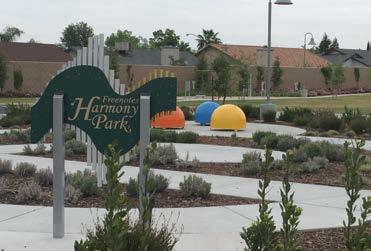
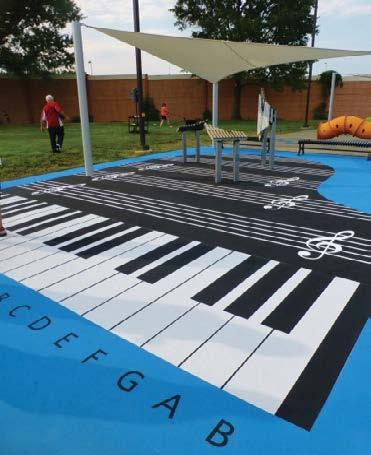
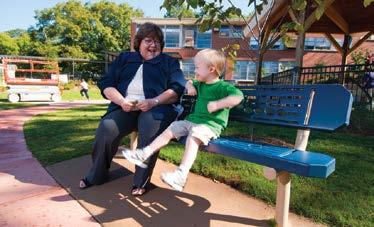
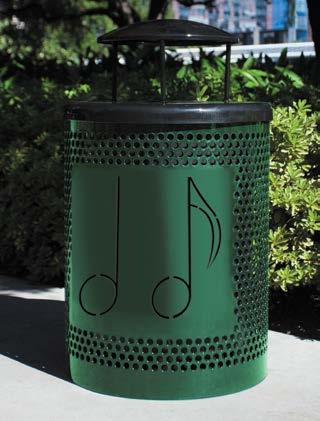
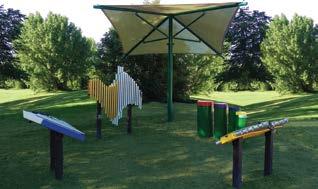
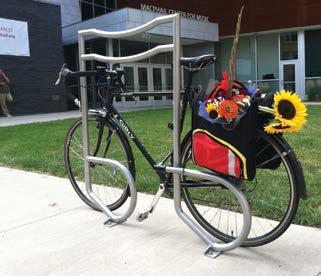
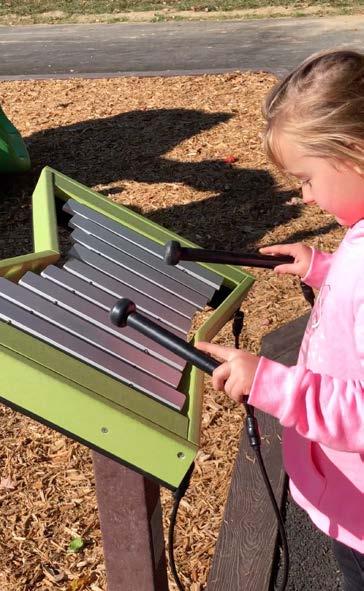
Sustaining Outdoor Music Environments
After planning, designing, and installing quality outdoor music environments, consideration should be given to maintenance and care of the instruments. In general, outdoor music parks require little maintenance; however, proper selection, frequent inspections, and cleaning of the instruments are important to ensure extended usability and enjoyment for all.
Music Park Inspection and Maintenance
Musical instruments are relatively low maintenance but regular inspections can help increase the life of the products. Additional maintenance may be required depending on the site, usage, and weather conditions. Suggested inspection tips:
• Play the instrument(s) to check the sound and function.
• Clean the instrument(s) with soap and water if necessary and remove any trash or debris.
• Check mallet(s) for condition and proper attachment.
• Inspect all bar and chime attachment cables.
• To clean stubborn dirt or marks on aluminum chimes or keys use a residue remover recommended by the manufacturer.
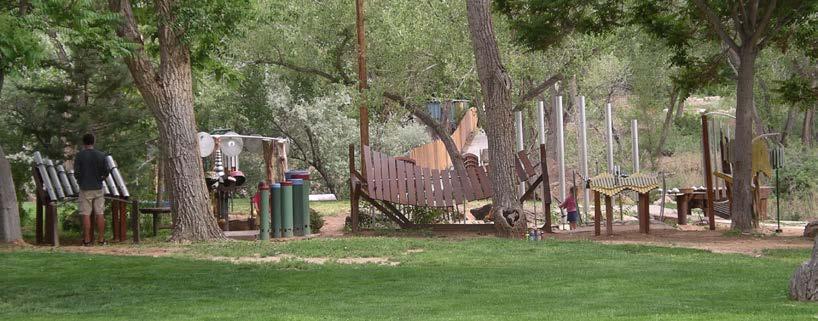
Inspection and Maintenance Considerations
Play the instruments regularly to check the sound and function. Instruments can be cleaned with soap and water. Be sure to check mallets for condition and proper attachment, and inspect bar and chime attachment cables. Additional maintenance may be required depending on the site, its amenities and surfacing, and volume of usage. To clean stubborn dirt or marks on aluminum chimes or keys, use a heavy-duty residue remover recommended by the manufacturer. For maintenance questions or replacement parts, contact the manufacturer. Maintaining and refreshing the outdoor music environment is an important part of ensuring its lifespan while also providing high quality music experiences for your community. Coordinating the outdoor music inspection with other maintenance routines, like nearby playground safety inspections, can help increase the visibility and consistency of proactive checks. Friends groups and other volunteer resources can also be helpful ambassadors and champions.
Quality and Durability
Quality outdoor musical instruments are designed and engineered to be extremely durable with a long-life span and should withstand weather; heat, cold, humidity, rain, snow, sleet, or hail. Some instruments come fully assembled and remain tuned throughout their lifetime, which helps ensure that the beautiful sounds will sustain as long as the instrument is intact. Even with normal wear and tear, quality outdoor instruments should still maintain the highquality sound they had the day they were installed. Ask the product manufacturer for a list of places that their instruments have been installed for ten years or more to get a better understanding of their quality. If high use and durability is a concern, consider choosing instruments made with non-PVC materials like anodized aluminum, stainless steel, or powder coated steel. Plastic resonators can crack over time and may not have the same lifespan as instruments made with more durable materials.
Maintenance and Care
High-quality products can be very low-maintenance but just like any outdoor space, music environments do require some maintenance to help increase their lifespan and ensure users have a great experience. Obtaining the manufacturer’s care and maintenance recommendations can help educate music park owners about the attention and care that will help ensure a longer lifespan and extended use. Depending on the surface used, the space may need to be mowed throughout the growing season, mulch may need to be replenished, and snow may need to be removed. Inspections of the instruments themselves are recommended on a planned and consistent cycle.
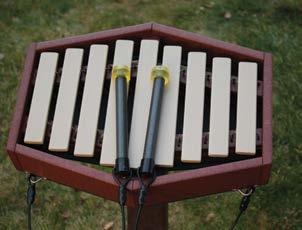
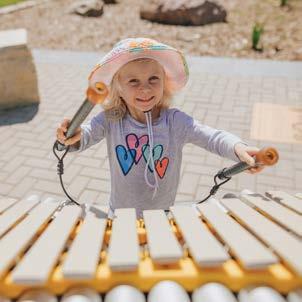
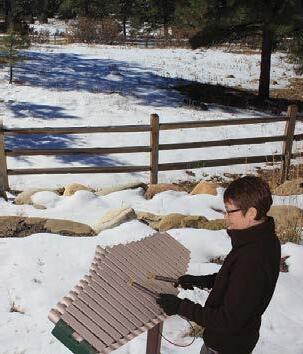
Activating Outdoor Music Environments
In order to activate the outdoor music park, increase usage, maximize the investment made, and increase overall vitality of the surrounding community, consider programming the space. Special events can engage individuals by providing opportunities to be inspired and learn while visiting the park.
Programming Your Outdoor Music Environment
Imagine stepping up to an instrument you have never played before and being able to create rhythmic and melodic music right away. Now, imagine the same experience while playing together with others on several instruments—all at the same time. Suddenly, beautiful music is being made through collaboration to the delight of everyone, including the players and those listening nearby.
There are numerous ways to activate the outdoor music environment to help diversify and increase the number of users. Visitors will naturally explore the instruments spontaneously, but additional interest can be added to the site through programming and special events. Special events and playful activities can be valuable ways to attract diverse user groups for further exploration and guidance that stimulates creativity and happiness. Invite a local high school band to help animate a grand opening or special celebration, encourage a local arts group to take a field trip there, or schedule an outdoor exercise class there to incorporate movement and music in a new style. Programming can offer unique activities that guide multigenerational audiences through a whole new vocabulary for expressing themselves beyond self-led exploration.
Improvisation activities can help users discover a greater awareness of the instruments, develop listening and musical skills, and further social sensitivities in the players while they are also having a lot of fun. In addition, some of the musical skills developed include an awareness of high/low pitch, rhythm and melody (through singing and playing), steady beat and articulations, and interaction/improvisation. Musical activities help with social sensitivities by allowing individuals to express their feelings, create, cooperate, practice assertiveness, gain self-confidence, and develop patience, sharing skills, and an appreciation for others. Activities can also be designed to help meet specific educational goals and objectives, and can even be aligned to national learning standards. Instructors can lead groups through a variety of musical concepts, such as rhythm and melody, improvising and composing, combining motor skills and verbal skills, and listening to self and peers. Programming activities can be designed for short and longer periods of time. Additional loose parts and props can help create multisensory experiences and can be tailored for individual instruction or collaborative group exploration. To help spur the imaginations of your community members, programmers can share activity starter ideas.
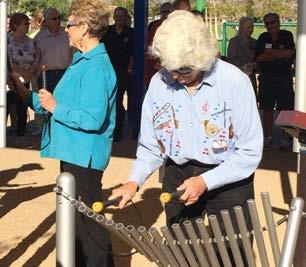
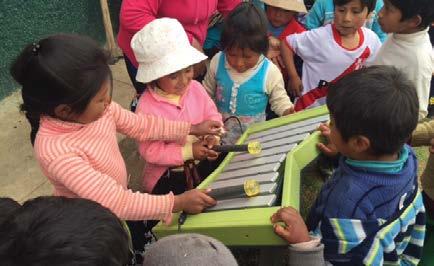
Music & Movement Activities
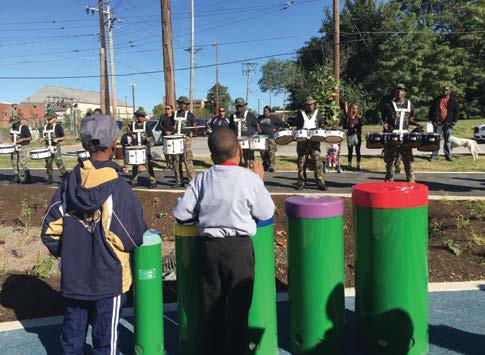
Time for a rhythmic conversation! Here is a fun way for play leaders, teachers, and parents to get children to participate in a conversation.
One child “talks” while the other one listens. Then, they switch. Begin by asking the children some of the following probing questions.
What would a conversation with a friend sound like?
Look at your friend playing another instrument. Ask him or her to talk with you through your instruments. For example, What would your name and your friend’s name sound like when played back and forth?
First, you play or call your friend with your name. Then, your friend responds to you with his or her name. This is a call and response using the rhythm and melody of your names. What would your names sound like played together? Listen closely to hear how they might combine in what is called improvisation. What would a conversation with your friend sound like with your favorite animal? Your favorite color? What rhythms and melodies do they create?
What would your conversation sound like if you asked your friend a question through your instrument, and he or she answered you?
Think of a question you could ask your friend through your instrument. For example: how are you feeling today? What would that question sound like played on your instrument? Then, your friend answers your question with how he or she is feeling. Listen closely to the rhythms and melodies.
What would an echo sound like with your friend?
Think of a rhythm and melody (maybe the sound of your name) and play it on your instrument and have your friend echo that rhythm. Listen to the echos between you and your friend.
What would a free improvisation sound like?
Using all the ideas you have explored in the activities above, discover what sounds you and your friends can create together in what is called a free improvisation. Listen closely to each other for a conversation that might unfold. Listen for a call and response... A question and answer... A steady beat that you can make sound pretty.
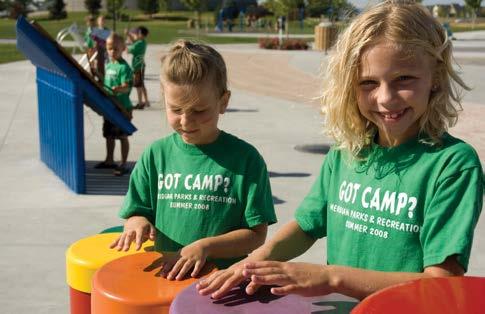
Ever listen to your heart beating?
It is very constant. Have the children find their heartbeat and listen to it. Your heartbeat is a lot like the beat in music. As a group, clap a rhythm similar to a heartbeat. Start with a simple, slow, single beat. Now, play your heartbeat on an instrument. The other children can play the instruments or clap along. Allow some of the children to walk around at the same beat. Then, switch the class so everyone can participate on both sides.
Looking at fast and slow: What would your heartbeat sound like if you were running or dancing?
How about while you are playing your favorite sport? Allow some children to play the faster rhythm on an instrument while others act out the running, dancing, and playing sports. Ask them to “freeze.” How do the children who have been active feel? Is their breath and heartbeat faster? Then, switch the groups so everyone can participate on both sides. What would your heartbeat sound like if you were resting or sitting quietly? Repeat the process using a slower beat.
A beat is not the only thing used to create music! Now, combine the heartbeat with other sounds to make a song.
One child or group of children can play the “heartbeat” or rhythm while another child begins to just play whatever comes to mind. What would nature sound like? The wind? A river? A bird? Anything can be “played” on a music instrument. Children can all participate by dancing, hopping, jumping, or just moving to the beat and the music being created. Allow as many children as possible to compose on the instrument(s). Try to use both slow and fast beats! What would an echo sound like with your friend? Think of a rhythm and melody (maybe the sound of your name) and play it on your instrument and have your friend echo that rhythm. Listen to the echos between you and your friend.
If you can use more than one instrument, try letting the children play all together. What happens after a period of time? How does the music change depending on the slow or fast beat?
Music & Science Activities
Want to introduce some science into your day? Here is a fun way to look at the rhythm of our hearts through questions and discovery!
Beyond organized education programs in the outdoor music park, consider other programming ideas, like therapeutic programs that will include older adults or children with disabilities, summer camp activities, field trips, team building events, and even fitness programs.
For example, according to the American Music Therapy Association (AMTA), music provides intrinsic healing elements that promote the human healing process. Consider reaching out to the local special populations groups—senior centers, rehabilitation centers, and so forth—who could benefit tremendously from having a music session at the outdoor music park. In addition, individuals with Autism Spectrum Disorder (ASD) may have heightened musical aptitude and sensitivity to musical elements. Individuals with ASD may also benefit from music therapy intervention.
Summer camp activities in the outdoor music park can expose children to music. Whether children have music experience or not, the music park will be a fun and engaging activity. This may be a good opportunity to engage children in a new and exciting activity while being surrounded by nature. Summer camps may decide to hold activities in the music park for an hour, half a day, or even several days.
Many schools may not have the resources to run a music program. Providing a location for schools to bring the classroom outdoors to the music park may be a great experience for students while fulfilling part of the curriculum without an additional expense. Hopefully, their experience will be so rich that participants will return after school and on weekends to share what they have learned with their families.
Many corporate, fraternal, or non-profit groups may be looking for unique team building activities. Creating sample activities will allow teams to be creative and to discover the outdoors in new ways. They could play the instruments, sing, write catchy jingles, etc.
Incorporating the outdoor music environment into fitness programming is another viable use of the space. One example is to provide an opportunity for the local community to enjoy the outdoor music space while experiencing the relaxing and healthful benefits of yoga. Most yoga sessions typically include breathing exercises, meditation, and assuming postures (sometimes called asana or poses) that stretch and flex various muscle groups. The purpose of yoga is to create strength, awareness, and harmony in both the mind and body, and harmonious music without lyrics is often played at indoor yoga studios to promote awareness and calm. The soulful music that your music park creates offers another dimension to the relaxing effect yoga has on the mind, spirit, and body, and allows yogis to take their practice outside.
Other programming ideas include inviting the local orchestra to play in the park, installing music parks in parklets, or inviting a choir for a special holiday. Let your imagination run free; there are many different ways you can enjoy the space with your community while explaining the many benefits of music.
“Music is therapy. Music moves people. It connects people in ways that no other medium can. It pulls heart strings. It acts as medicine.”
-Benjamin Hammond Haggerty, American Rapper and Songwriter
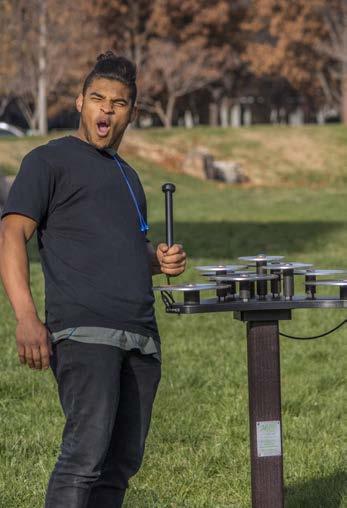
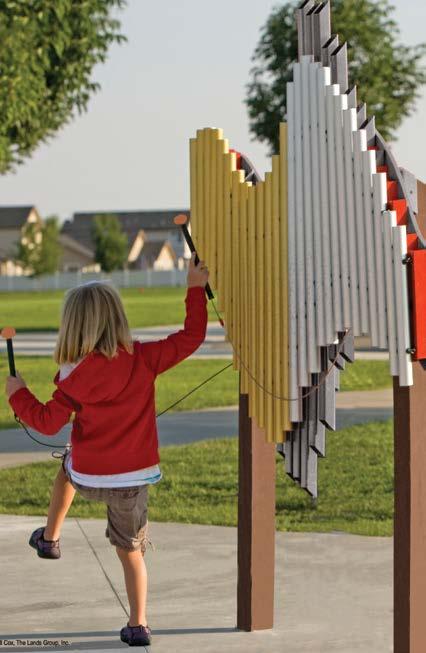
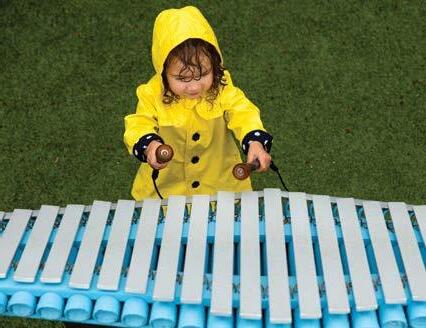
Funding & Marketing Music Projects
It is never too early to start promoting your project and optimizing every chance to raise awareness and gain support. Even the early stages of the planning and design phases of your outdoor music project provide numerous opportunities for creating community awareness and support along the way. Developing human stories and personal testimonials can be very effective strategies for triggering broad-based emotional support as everyone can relate to the social and emotional benefits that music can so powerfully provide.
Friend and fundraising activities are also beneficial ways to market the uniqueness of your project and the intended benefits for the community. Encourage your planning team to research local, regional, and national partners for your project. Is there a local music store in your community that might be interested in sponsoring an outdoor setting? Outdoor music parks are ideal for corporate giving initiatives and are also ideal for company volunteers to complete community volunteer hours to help with installation and grand opening events.
Other communities have raised funds through their local services clubs and non-profit organizations. Music academies could also be potential partners for your music park. Some communities have partnered with academies and have found the experience extremely fulfilling. Another viable option is to consider creating a “friends of the music park” group or committee allowing members of the community, musicians, music-store owners, and instructors to collaborate and build momentum while funding the park.
Press releases and other promotional activities that recognize donors and supporters can help you express appreciation while also generating additional interest. Celebrating your grand opening with a community event is another emotional way to recognize community stakeholders while attracting users to visit the new installation.
Marketing and promotional efforts can also be utilized to increase usage of the space. Creating an effective marketing campaign is an important step in the program’s ongoing success. To most effectively reach your target audience, start by identifying and understanding who they are and the best ways to reach them. What kind of information gets their attention and how should it be promoted? Potential users can be recruited through local neighborhood groups, schools, childcare centers and after school settings, parent groups, meeting halls, local gyms, recreation centers, hospitals, and therapeutic settings — just to name a few.
Distribute flyers and brochures to places where your target market can be found. Partnering with local schools, faith-based organizations, parks and recreation, and fraternal organizations can also provide a meaningful outlet to promote the new music park and your programming. Consider making personal visits and offering live demonstrations to accentuate the benefits in a hands-on way. If your organization distributes a newsletter, be sure to include information about the site as well as scheduled program activities, information, and links to a website or other portal where interested parties can learn more and get involved.
Utilize social media to promote your outdoor music location, programs, and schedules. Creating photo albums on Flickr or a photo-sharing site is another way to involve the community and to illustrate the real enjoyment that the outdoor music environment provides. Photos often tell a story better than words, as viewers can experience the emotion of the participants through effective imagery. Remember, social media is a two-way tool, so ask users to post photos playing the instruments and tag your organization in their images to help spread the word.
Your website is one of the most important tools for distributing public information about your site, programs, and events. Since potential users often use the Internet to search for recreation ideas, ensuring that your website has photos, programs, and information about the music park is a critical tool for effectively communicating and marketing your unique community asset.
Gathering feedback from users is an effective way to gain information, fuel improvements, and increase
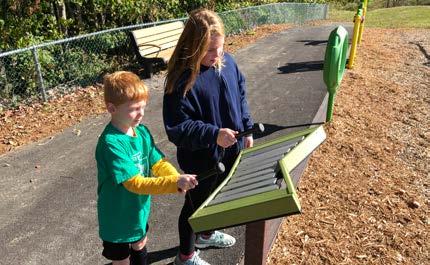
community visibility, and there are a variety of ways you can collect input from users and participants. Having a digital presence on sites like Yelp, Foursquare, and Google Business, listings invites users to rate your music park and its programming. These reviews will show up when people view the music park on these sites.
If your installation is part of a facility and/or adjacent to a building, survey posters are easy ways to invite users to take an online survey about their experience. Post notices in the restrooms, on bulletin boards, near water fountains and at information desks so they are highly visible. Be sure the URL to the online survey is short and memorable. Post electronic survey links on your website and social media pages and provide paper forms for people to fill out and submit on site if possible.
Paying special attention to the feedback provided and responding to online comments, whether they are positive or negative, demonstrates to the community that you are listening and care about people’s opinions.
There are many other ideas to fundraise and market the music park. Renting the space for birthday parties may also be a great solution for raising funds to maintain and install new instruments to the music park. A community working toward a common goal will get behind these efforts wholeheartedly as it will benefit the community and its individuals directly.
With the right mix of marketing, programming, and follow up, your music park can become one of the treasured gems of the community. Positive momentum can also be instrumental in fueling expansions, renovations, or additional projects in the future.
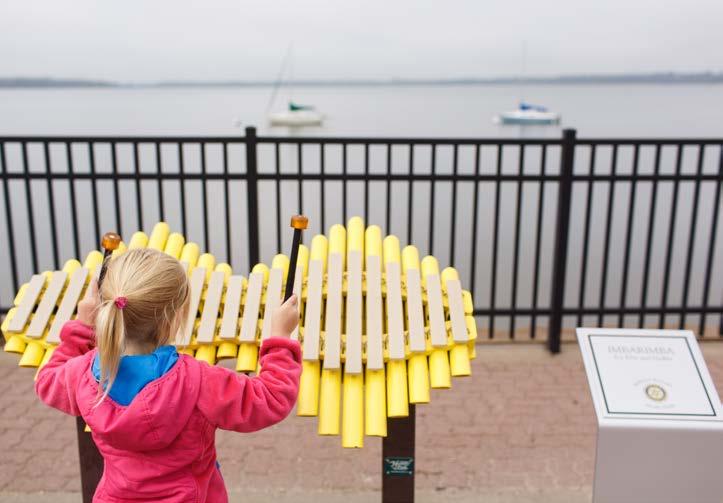
City of Buffalo Rotary Club Adds Unique Lakefront Music Trail Case Study: Buffalo, MN
The idea of creating a musical trail was a vision of former Buffalo Rotary Club President (2013-2014) Dr. Warren Stoltmam. Dr. Stoltman’s dream not only became a reality, but it has resulted in more music and community engagement for citizens of the City of Buffalo.
In his early research, Dr. Stoltman discovered that the Maple Grove Rotary Club added musical instruments to a common space near its public library. Dr. Stoltman was impressed with their installation, but knew he wanted to change the typology for Buffalo. He stated, “In Maple Grove all the instruments are grouped together.” A key design goal for Buffalo was to engage people as they moved along a linear path. Another goal was to make sure that children or adults could connect through eye contact while playing the instruments, according to
Contributed by Camille C. Calderaro, MLA, ASLA, Fireflies Play Environments, Inc.
Camille Calderaro, the space designer from Fireflies Play Environments, Inc.
As the project moved forward, Dr. Stoltman and Calderaro considered installing the instruments on the docks with the idea of sound carrying over the waters of Buffalo Lake. Dr. Stoltman also envisioned large percussive instruments installed along the walking path on the edge of Buffalo Lake and through Sturges Park. That vision became a reality. The Sturges Park lakefront trail features tuned drums, huge xylophones, bells, a large wind chime, and a playground ensemble.
With the help of Calderaro, all the instruments were arranged so they can be played by individuals or groups walking along the trail.
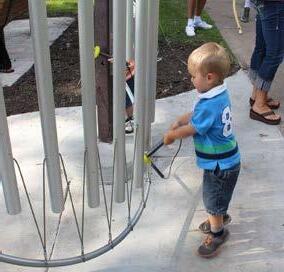
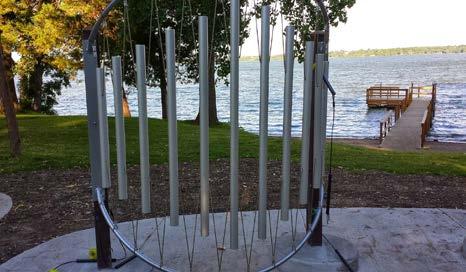
“I was amazed and mesmerized. Here was this instrument overlooking the lake. There was something powerful in looking over the water, feeling the breeze, and enjoying the sounds from these instruments. It touched a place inside my spirituality.”-Camille C. Calderaro, MLA, ASLA, Fireflies Play Environments, Inc.
As Calderaro and Dr. Stoltman walked the lakefront trail to review final placement of the instruments, the musical instruments seemed to indicate where they wanted to be sited. The plan changed slightly but the end results was even better than expected. The project brought the community together musically, and also through the highly successful fundraising effort.
The project was implemented by the Buffalo Rotary Club with the help of many people and organizations in Buffalo, MN, including the City of Buffalo, Parks and Recreation, the Buffalo Chamber of Commerce, and many Buffalo residents. It seemed that the whole community contributed to the project, as donations from the Buffalo Community Orchestra, Buffalo Hospital, Elim Care, and numerous other corporate sponsors poured in once word spread in the community about the music trail.
The Buffalo Rotary Club fundraising included grants through the Central Minnesota Arts Board and Rotary’s Matching Grant Program. Although the original plan was to raise $35,000 to buy nine instruments for installation on the walking path, the club exceeded the expectation in approximately six months. The fundraising was so successful that they were able to buy and install 11 instruments. With so many instruments, the proposed installation area was expanded to the Downtown Buffalo Commons, where a sculptural Swirl and large bass tone xylophone are installed.
Response to the addition of musical instruments to
Sturges Park and the walking trail has been very positive. Residents who live near the park have enjoyed the spontaneous music, and there do not seem to have been any issues with vandalism. Some individuals think it is strange to have musical instruments outside, especially in Minnesota, but these instruments are made for the outdoors. The instruments were specifically selected knowing that they are made of metal, are weatherresistant, and are sturdy enough to last through many Minnesota winters.
Dr. Stoltman, an eye doctor in Buffalo, told the story of a patient whose care attendant could not persuade him to get the exercise he needed. But ever since the installation of the musical instruments in the park, “It hasn’t been a chore,” he said, “I want to go play the instruments and walk in order to play them.” In a sense, the music of the trail is therapy for him.
Music therapy is just one of the functions of the Music Trail. The instruments are designed so they can be played by adults or children, with or without any musical training. They can be played by serious musicians, or just for fun. But the instruments are also quite beautiful, adding to the scenic view of the lake seen from almost anywhere nearby. Mixed in among the flower gardens planted and maintained by area organizations, and with a backdrop of the fountain in Buffalo Lake, the well-designed instruments are almost like another art installation in Buffalo. They bring a sophisticated feeling to the park, as though it were a musical sculpture garden.
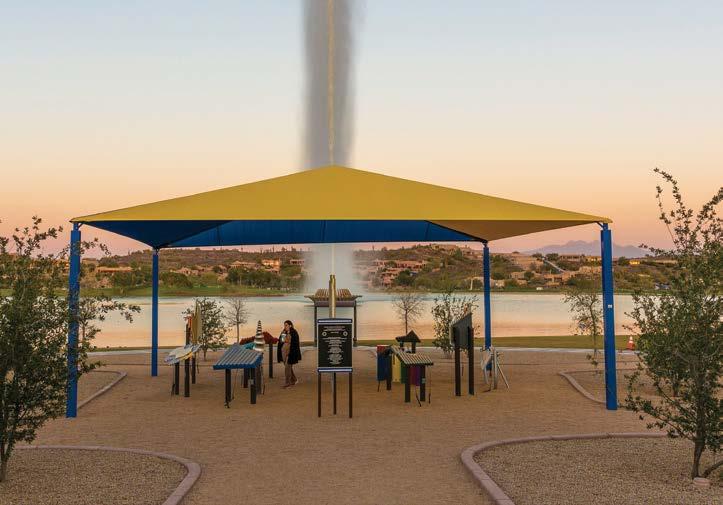
Sculptural Fountain Hills Musical Instrument Park
Case Study: Fountain Hills, AZ
While academics are clearly the cornerstone of any education system, this often leaves an imbalance in funding for other programs, and inevitably leaves little opportunity for exploration of the arts. Music, drama, and art programs are often the first to be cut, resulting in children having diminishing exposure to the creative outlets they need. Studies have proven over and over that artistic channels are vital to the health and development of our youth. Even in an unstructured setting, kids need the opportunity to express themselves through music, dance, painting, drawing, and more. The Town of Fountain Hills understands wholeheartedly the importance of individuals’ development through music. Therefore, the parks and recreation department, in partnership with the Four Peaks Rotary, Fountain Hills Rotary and Fountain Hills Cultural and Civic Association,
recognized the need and has added a distinct and unique park amenity.
The park was designed and dedicated to allow kids of all ages to channel their creative energies into music. The park was designed with 14 harmonized instruments so that one or all could be played in a complimentary fashion, and even the most novice musician would find success in an impromptu jam session. The park also features a shade canopy, seating, and ADA compliant surfacing and access, to make it available to all. The instruments themselves are designed to be interactive sculptures, engaging not only the sense of sound but also the visual aesthetics of the pieces.
Kevin Snipes, Supervisor of Parks for Town of Fountain Hills, AZ said, “The music park serves a purpose beyond
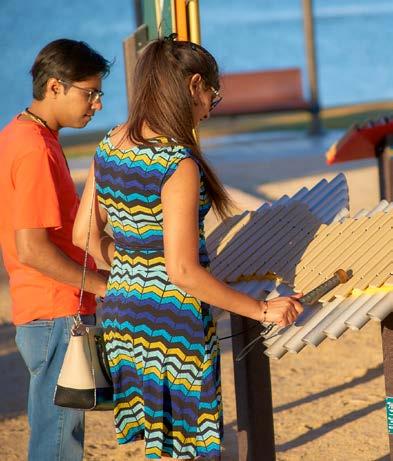
“This park is not only a beautiful addition to our already expansive Fountain Park, it is a facility that inspires creativity, ingenuity, and youthful energy for both the young and young at heart.”-Kevin Snipes, Supervisor of Parks for Town of Fountain Hills, AZ
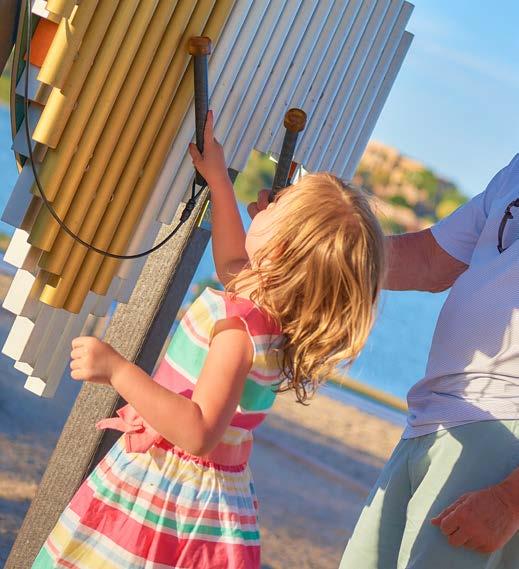
a fun amenity. It provides an outlet for stress and emotional expression, encouraging wellness, movement, socialization, memory retention, and more. We can think of no better outlet in our technology-focused age than to recreate outdoors, making captivating, spontaneous music. Our park is enjoyed by all ages. From young toddlers to seniors who are young at heart, the musical playground has our entire community singing its praises.”
All of the instruments in the musical park are made of resilient plastics and metals, giving the park a durable longevity for generations to come. The shaded park not only keeps the sun from beating down on perspective patrons but alleviates sun-related wear and tear on the structures. The musical instrument park is all acoustic and therefore completely electricity free, maintaining its environmental sensitivity and reducing future maintenance or upkeep.
The Harmony Park was paid for completely through the fundraising efforts of the local Four Peaks Rotary Club.
The Rotary Club worked diligently for almost a year, setting up donation stations and hosting events in order to raise the $70,000 needed to bring the park to fruition. Initially the Rotary Club set forth a goal to raise enough money to install the music park in phases. The first phase was to include 8 instruments, however, their fundraising effort were so strong that 12 instruments were installed in one single phase. This included enough fundraising money to also pay for the shade structure above the music playground.
The Harmony Park Musical Instrument Park is a facility that the community is proud to have in Fountain Hills. It is thanks to a strong partnership between the Town of Fountain Hills and the local civic organizations that they were able to give to the community such a unique park. This park is not only a beautiful addition to the already expansive Fountain Park, it is a facility that inspires creativity, ingenuity, and a youthful energy for both the young and young at heart.
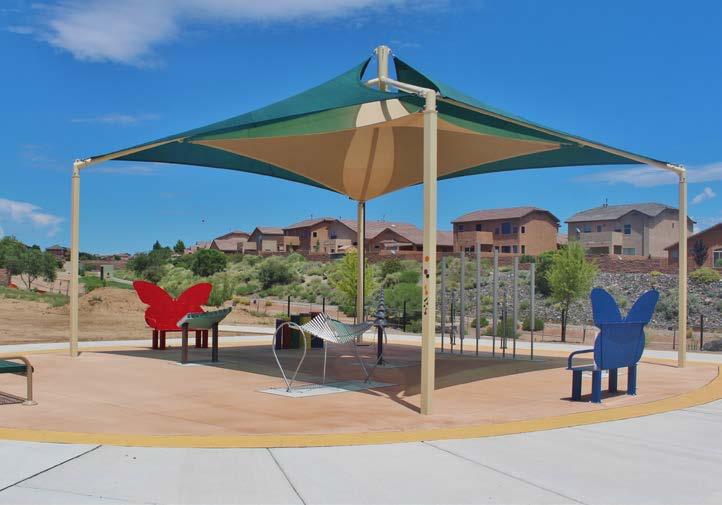
A Symphony of Inclusive Sounds at the Playground Case Study: Rio Rancho, NM
The dream of an all-inclusive playground with an adjoining music park become a reality at A Park Above, the first inclusive playground in New Mexico. The sixacre park accomplished the goal of creating a space where all children can come together through the gift of play. A diverse environment with therapeutic equipment, calming places, and opportunities for physical activity help meet the interests of all users.
A Technical Advisory Committee (the TAC team), including parents, teachers, doctors, people with or without disabilities, children, and physical therapists, were involved in the design of the unique space. The TAC team wanted to ensure that there was a lot of sensory stimulation; a space that allows children to be as physically active as they want, while also providing
Contributed by Dyane Sonier, Resource Development Manager, City of Rio Rancho, Rio Rancho, NM
opportunities for those prefer more relaxing experiences. Additionally, it was important to them to go beyond the typical sounds in the playground by creating a music park as part of the environment. Making music is now something all kids can experience as they explore rich, deep tones, and sparkling high notes in this creative play space. The music park, one of many activities in the park, includes a 6-piece ensemble installed under a shade structure, to help combat the heat throughout the year.
What was originally conceived as a neighborhood park has since become a regional park and a viable destination as families travel from as far as Colorado to visit the park regularly. The total park project budget was over $2 million and was the result of many public and private donors contributing to the success. Local
“A Park Above has become a new design standard that we are trying to achieve, at least in part if not whole, at our older, existing parks as we work to renovate them to meet the current needs of our community. This park and the various sensory experiences that children can have here, have opened up a new world of play and growth for many who could not play at our other parks, as well as the parents, friends, and other family members that share the experience with them. While other playgrounds in the city may have a few bells or chimes built into the playground equipment, the symphony of sound that children and families can make at A Park Above is unique, and makes the “music park” area of the facility a favorite place to socialize and play.”
- Dyane Sonier, Resource Development Manager, City of Rio Rancho, Rio Rancho NMnon-profit organizations, hospitals grants, park impact fees, and in-kind donations helped provide funding and labor for the park project.
A Park Above opened in March 2016, and today an average of 600 people reportedly visit the park during the week while over 1,000 visit during the weekend. The city has established ambassadors that serve as liaisons among visitors, community members, and the Rio Rancho Department of Parks and Recreation.
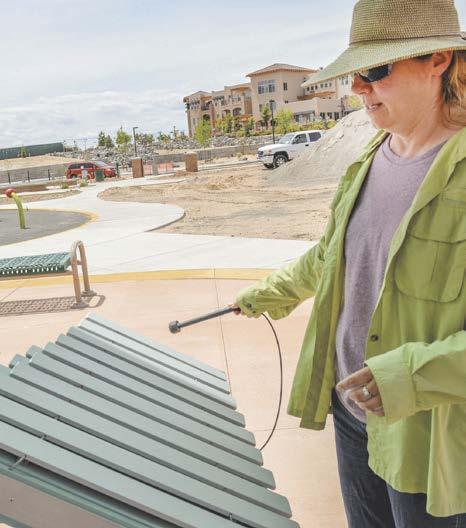
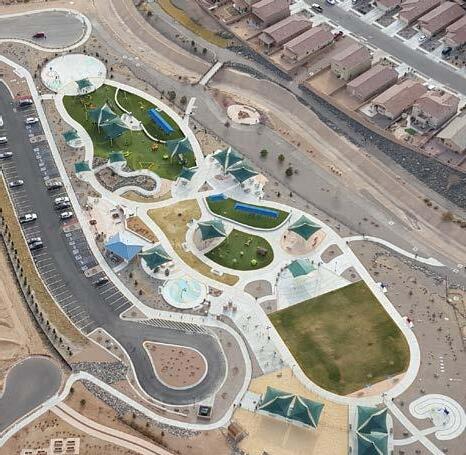
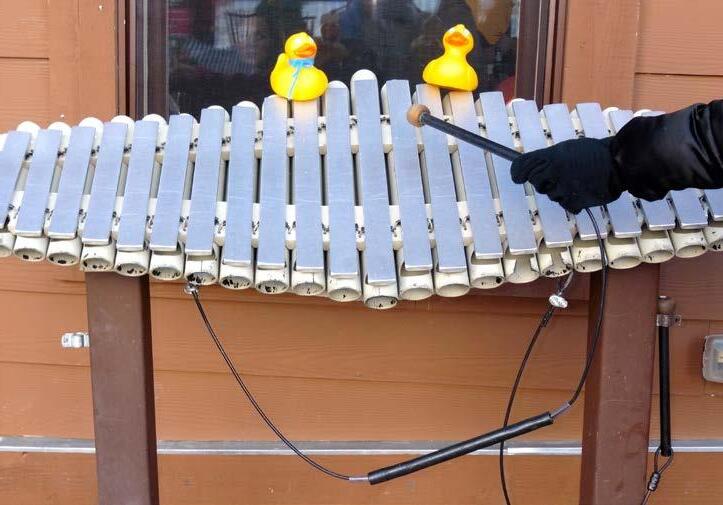
Animating a Village with Music Case Study: Winter Park, CO
The Village at Winter Park Resort is a vibrant commercial area adjacent to the Winter Park Resort ski area. With shops, restaurants, and a wide range of services from a spa to snowmobile tours, The Village draws guests of all kinds. The Village Company, a board-governed association that runs The Village, sought to enhance the area by giving guests better opportunities to interact with The Village, and attracting them to stay longer and visit the businesses within.
Five instruments have been strategically placed throughout the Village, and it has been amazing to see how people interact with the instruments and with each other. The instruments have successfully integrated animation across The Village as they guide guests through, playing as they meander from one end to the other. A unique challenge the Winter Park Resort faces in a mountain ski resort is that the instruments are in a very harsh environment year-round. The team has
Contributed by Carrie Hanneke, Winter Park Resortbeen creative and proactive with their maintenance planning and as a result, visitors are able to enjoy the playful amenity all year long. Installing retro-fitted bases on heated pavers protects the piping for the heating systems and extends the usage of the instruments. In addition, custom signage helps promote usage while also reminding guests to respect evening quiet hours.
Given the close proximity of the commercial area and the residential lodging, placement of the instruments and signage were important site-specific considerations during the planning process. An alto/soprano xylophone, alto/soprano chimes, soprano chimes, bass xylophone, alto/soprano bells, and drums are scattered around the commercial area of the park. Children and adults alike enjoy exploring the beautiful sounds while also appreciating the aesthetic benefit to the overall landscape. Administrators comment, “it is exciting to see children running to the instruments and parents
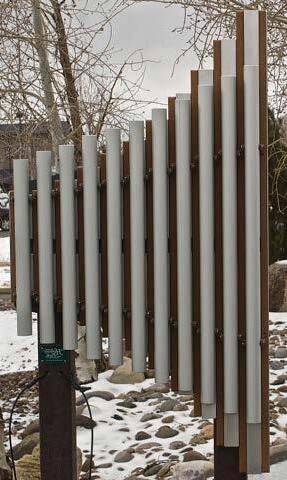
“I love seeing kids race to the instruments! And it’s great that there are multiple mallets at each one, so the musicians can literally make beautiful music together.”
-Carrie Hanneke, Winter Park Resort, Winter Park, CO
trying to peel their kids away as they move to their next location.” None of the guests have to be a musician to make music. The instruments were placed throughout the area since the sound is never too loud or obtrusive that it bothers nearby people. Sometimes, while guests are playing the instruments, it sounds as if background music was being piped in.
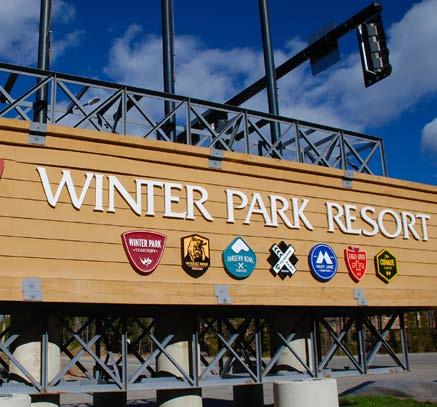
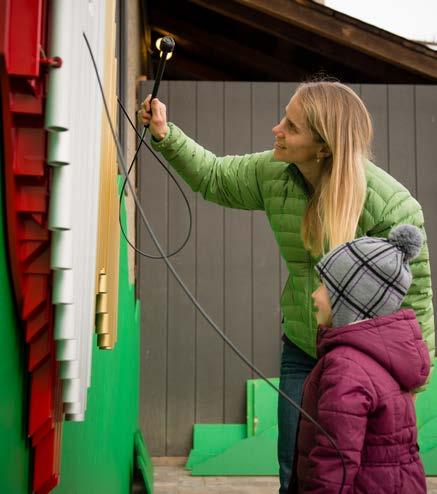
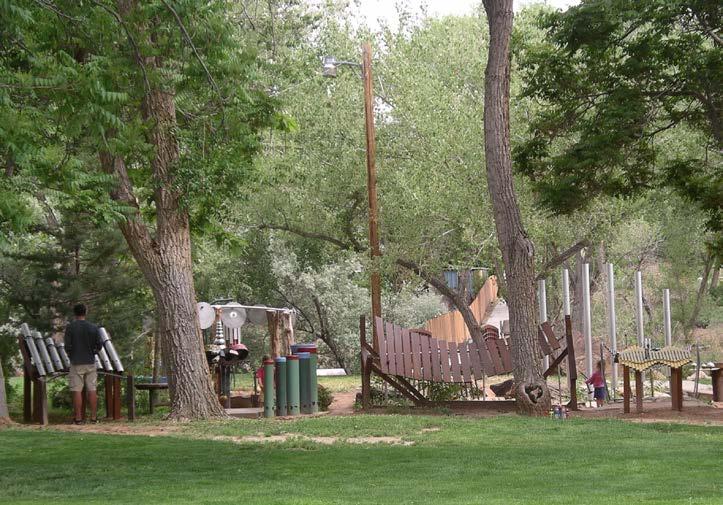
A Growing Ensemble for More Than 20 Years
Case Study: Moab, UT
The town of Moab is nestled next to the Colorado River in southeastern Utah’s canyon country desert. The summer sun is unrelenting and the winter nights bring freezing temperatures and occasional snows. It is a challenging environment, to be sure, yet it is also one of the most livable towns in the American Southwest and one of the most magnetic travel destinations internationally. The Moab Rotary Park, located on Mill Creek Dr., offers shade and quiet from the desert sun. An ADA accessible park, it also offers musical instruments, a playground, shelter and picnic tables, grills, sports court, an amphitheater, and public restrooms.
In the middle of this active, high desert Mecca sits the very first installation of a music park in the United States. The trail where the music park is located is surrounded
Contributed by David Olsen, Former Moab Community Development Director, Moab, UTby a stream built by community members. The trail has multiple uses but the most iconic feature is the “Xylophonus Rex,” an oversize xylophone. The xylophone was set up in Moab’s Rotary Park in 1996 and is still being played today thanks to the help of an anonymous contribution of $10,000. The only difference is that since then, the X. Rex is one of the many pieces in the largest ensemble of the music park and the largest collection of outdoor music instruments in the world. Xylophonous Rex has been in the ground for more than 20 years. The response from guests and neighbors of the park was so positive that more instruments were added. Some of the original instruments are still in the park and used today, others have been retired and replaced with new ones.
Moab Community Development Director, David Olsen,
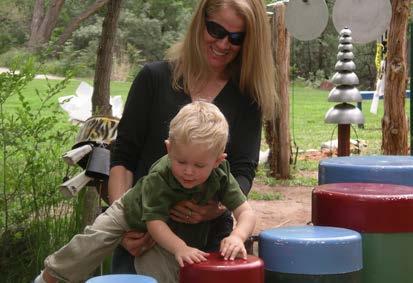
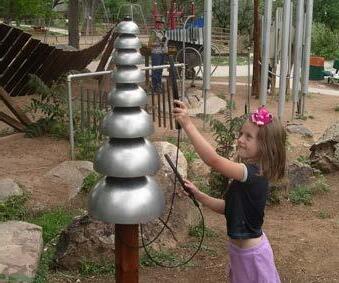
“I get more positive comments about the musical playground than anything. People actually pick up the phone – after a trip to Moab – to tell me, ‘That was the greatest thing we have ever seen in a park. We loved it. We want a musical playground for our community.’ People, of all ages, usually have a big smile on their face when they play the instruments. Here we are in Moab [surrounded by gorgeous National Parks] and we have visitors telling other visitors that they must go to Rotary Park and play the instruments.”
- David Olsen, Former Moab Community Development Directorwas the man behind the vision to install the X. Rex in Moab’s heavily traveled Rotary Park. Mr. Olsen has worked for the city for 25 years and received many different calls from other communities interested in creating a similar space. He expected children to be enthusiastic, but he was ecstatic by the overwhelmingly positive reception from the tourists and community at large.
According to Olsen, “I get more positive comments about the musical park than anything. People actually pick up the phone – after a trip to Moab – to tell me, ‘That was the greatest thing we have ever seen in a park. We loved it. We want a musical park for our community.’ People of all ages usually have a big smile on their face when they play the instruments. Here we are in Moab [surrounded by gorgeous National Parks] and we have visitors telling other visitors that they must go to Rotary Park and play the instruments.” The public’s enthusiasm inspired Mr. Olsen to add instruments the following year, plus a new instrument each ensuing year.
With a 16-year partnership between Moab and the outdoor music instruments manufacturer, Mr. Olsen has become an invaluable source of ideas for research and development. Some of his observations of the instruments in a high-use area have led directly to
enhancements that meet the specific needs of municipal leaders and park’ managers. Instruments are designed to mitigate vandalism concerns and continue the legacy of low-maintenance sensory additions to the landscape.
With instruments in the ground at Moab Rotary Park for more than 20 years, they are still making beautiful music for all who play. And Olsen has found that the numbers of those who play continue to grow. The musical playground is a captivating draw for young and old. It is a sight, and more importantly, a sound to behold. It has been such a feature in the area that PBS filmed a show at the park for everyone to see.
Community members and officials describe how most first-time visitors to the park experience a “wow factor.” Just like local residents have done for years, newcomers are drawn to the instruments and waste no time in creating music. Instruments have been installed in the park to invite musical exploration in people of all ages. Since the beginning, the instruments were designed to be low-maintenance and highly durable, even under harsh weather conditions. The park celebrated its 20th anniversary in 2015. The most recent instruments were added in early 2017. As of now, the Moab Rotary Park is the largest and oldest music park in the world.
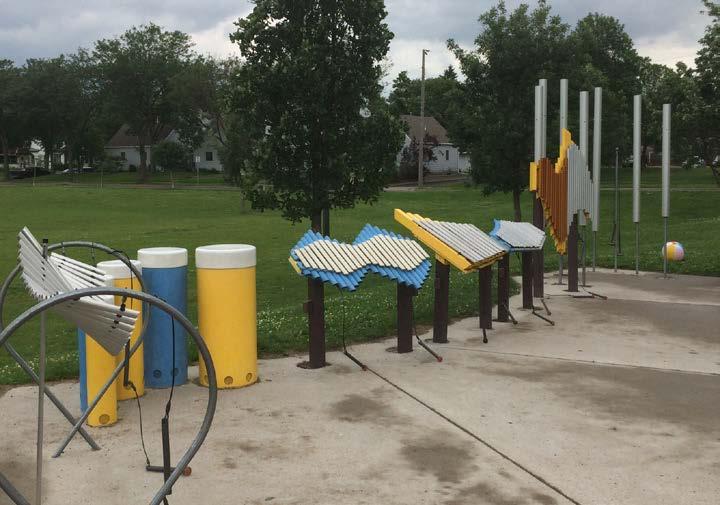
Rotary Club Brings Harmony to Minneapolis Playground Case Study: Minneapolis, MN
Kids, moms, dads, and neighbors in Northeast Minneapolis, including students from nearby Edison High School, can now play instruments to make music without lessons or experience of any kind. And sound great.
The seven new outdoor playground instruments that the Minneapolis City of Lakes Rotary Club donated and installed last fall at Jackson Square Park are tuned to the Pentatonic Scale, similar to wind chimes. That makes the instruments sound pleasant no matter who plays them.
The percussion-type instruments are the first of their kind in Minneapolis, the result of a $25,000 community service project by the Rotary club in celebration of its 25th anniversary last year. According to Doug Schmitt, a long time member and past president of the club, who headed up the project, the organization’s goals for the
Contributed by Richard L. Parrish, Charter Member, Director & Past President of the Minneapolis City of Lakes Rotary Club
unusual effort are to provide easy access for children to play musical instruments, and help people of all ages and cultures come together to enjoy making music.
“We’ve been involved in many community projects,” Schmitt said, “but this is the first time our club has actually built something in Minneapolis that will last for years to come. It’s widely believed that music helps students perform better in academics, as well as help build their leadership abilities.”
The new instruments were formally dedicated in late September with a colorful ribbon-cutting ceremony that was hosted by City of Lakes President Gayle Noakes. Speakers included Larry Zilliox, Governor of District 5950; Kevin Reich, Minneapolis City Councilman; and Elizabeth Wielinski, a Commissioner with the Minneapolis Park &
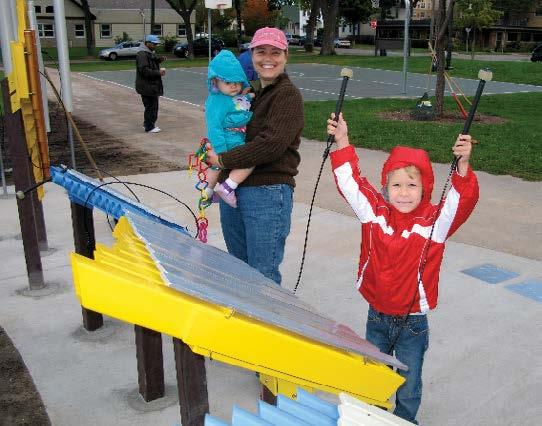
“The concept of music that anyone can make is really intriguing. It’s a great vehicle to promote music. It allows musically illiterate people to play with them. The idea is to peak somebody’s interest.”- Doug Schmitt, VP of Education for Schmitt Music
Recreation Board (MP&RB). Members of the Edison High School Band capped off the event by playing Beethoven’s “Ode to Joy” on the new instruments.
Northeast Minneapolis is one of the city’s older, more established neighborhoods that originally attracted many families from Poland, the Ukraine and other eastern European countries. Many of the area’s newer residents come from countries in Latin America, Africa and Southeast Asia.
The location for the playground instruments in Jackson Square Park was recommended by the MP&RB, because it designated that area of the city as an Arts District in 2003. The 2.3-acre park, which is owned and operated by the MP&RB, features several large outdoor sculptures in addition to a large playground area for kids, softball
diamond, volleyball and basketball courts, wading pool, picnic areas and other amenities.
The cost of the project also includes a $4,000 research component for the University of Minnesota’s School of Music in association with the Learning Through Music Consulting Group to see how people, especially school-age children, use the instruments. The research is not expected to begin until this spring.
In addition to donations by members of the Rotary club, major funding for the project was provided by two grants from Rotary International District 5950, which oversees 60 clubs in the Minneapolis metro area, central and southeastern Minnesota. The district receives donations from the clubs and Rotary International, then redistributes those funds back to clubs in the district that apply for community service grants.
City of Lakes Rotary Club members were also successful in persuading a number of local organizations to donate thousands of dollars of in-kind services to make the playground project a success. Besides the MP&RB, they included the SmithGroup for engineering and site design; J.J. Vandermyde for community relations; Knutson Construction Services for planning and general contracting; Bollig & Sons for excavation and construction; Apple Valley Red-E-Mix for concrete; Mortenson Construction for concrete finishing; and Productivity, Inc. for embossed steel name plates.
The seven percussion instruments were designed and manufactured by Freenotes Harmony Park in Hesperus, CO. They were installed in a concert-style, semi circle formation in front of an area where a conductor may stand. However, planners expect the instruments to be played mostly by children of all ages who visit the park.
References & Resources
1 TMithen, Steven. The Singing Neanderthals: The Origins of Music, Language, Mind, and Body. Cambridge: Harvard University Press, 2006.
2 ΤTesting models for the beginnings of the Aurignacian and the advent of figurative art and music: The radiocarbon chronology of Geißenklösterle. Journal of Human Evolution. 2012; 62(6): 664-676.
3 R. W. Wilkins, D. A. Hodges, P. J. Laurienti, M. Steen, J. H. Burdette. Network Science and the Effects of Music Preference on Functional Brain Connectivity: From Beethoven to Eminem. Scientific Reports, 2014; 4: 6130 DOI: 10.1038/srep06130
4 Blood, Anne J. and Robert J. Zatorre. “Intensely pleasurable responses to music correlate with activity in brain regions implicated in reward and emotion.” Proceedings of the Natural Academies of Sciences. Sept. 25, 2001.
5 Hallam, S., Creech, A., Varvarigou, M., & McQueen, H. (2012). Perceived benefits of active engagement with making music in community settings. International Journal of Community Music, 5(2), 155-174.
6 Iyendo, T. O. (2016). Exploring the effect of sound and music on health in hospital settings: A narrative review. International Journal of Nursing Studies, 63, 82-100. doi:http://dx.doi. org/10.1016/j.ijnurstu.2016.08.008
7 Winerman, L. (2005). The mind’s mirror. American Psychological Association. 36(9): 48.
8 Dingfelder, S. (2005). Autism’s smoking gun? American Psychological Association 36(9); 52.
9 Azar, B. (2005). How mimicry begat culture. American Psychological Association 36(9); 54.
10 Merriam, A.P. (1964) The Anthropology of Music, Northwestern University Press.
11 Selhub, E.M. and Logan, A.C. (2014). Your Brain on Nature. Collins.
12 Chanda, M.L. and Levitin, D.J. (2013). The Neurochemistry of Music. Trends in Cognitive Sciences. 17(4).
13 Bratman, G.N., Hamilton, J.P., Hahn, K.S., Daily, G.C., and Gross, J.J. (2015). Nature experiences reduces rumination and subgenual prefrontal cortex activation. Proceedings of the National Academy of Science, 112(28).
14 Gladwell, V.F., Brown, D.K., Wood, C., Sandercock, G.R., Barton,
J.L. (2013). The great outdoors: how a green environment can benefit all. Extreme Physiology & Medicine, 2:3.
15 Vinoo Alluri, Petri Toiviainen, Iiro P. Jääskeläinen, Enrico Glerean, Mikko Sams, Elvira Brattico. Large-scale brain networks emerge from dynamic processing of musical timbre, key and rhythm. NeuroImage, 2011; DOI: 10.1016/j. neuroimage.2011.11.019
16 Men W., Falk D., Sun T., et al. (2014) The corpus callosum of Albert Einstein‘s brain: another clue to his high intelligence? Brain. 137(4):e268.
17 Loewy, J. Stewart, K. Dassler, A.M., Telsey, A., Homel, P. (2013). The Effects of Music Therapy on Vital Signs, Feeding, and Sleep in Premature Infants. Pediatrics, May (131), issue 5.
18 Baycrest Centre for Geriatric Care. (2015, February 2). More evidence that musical training protects the brain. ScienceDaily. Retrieved October 9, 2017 from http://www.sciencedaily.com/ releases/2015/02/150202132611.htm.
19 Rauscher FH, Shaw GL, Levine LJ, Wright EL, Dennis WR, Newcomb RL. (1997). Musical training causes longterm enhancement of preschool children’s spatial reasoning. Neurol Res, Feb 19(1): 2-8.
20 Miendlarzewska, E. and Trost, W.J. (2013). How musical training affects cognitive development: rhythm, reward, and other modulating variables. Frontiers in Neuroscience, 7: 279.
21 Barrett K. C., Ashley R., Strait D. L., Kraus N. (2013). Art and science: how musical training shapes the brain. Front. Psychol. 4:713 10.3389/fpsyg.2013.00713
22 Southgate, D.E., & Roscigno, V.J. (2009). The impact of music on childhood and adolescent achievement, Social Science Quarterly, 90(1), 4-21.
23 Hallam, S. The power of music: Its impact on the intellectual, social, and personal development of children and young people. The Institute of Education, University of London.
24 Zentner, M. and E. Tuomas. (2010). Rhythmic engagement with music in infancy. PNAS 107 (13): 5768–5773.
25 Boer, D. and A. Abubakar. (2014). Music listening in families and peer groups: benefits for young people’s social cohesion and emotional well-being across four cultures. Frontiers in Psychology, Developmental Psychology 5 (Article 392).
26 Berger, A.A. and S. Cooper. (2003). Musical Play: A Case Study of Preschool Children and Parents. Journal of Research in Music
Education 51 (2): 151–165. 31 Burton, S. (2002). An Exploration of Preschool Children’s Spontaneous Songs and Chants. Visions of Research in Music Education 2.
27 Burton, S. (2002). An Exploration of Preschool Children’s Spontaneous Songs and Chants. Visions of Research in Music Education 2.
28 Juniu, S., T. Tedrick, and R. Boyd. (1996). Leisure or Work?: Amateur and Professional Musicians’ Perception of Rehearsal and Performance. Journal of Leisure Research 28 (1): 44–56
29 Pearce, E., J. Launay, and R.I.M. Dunbar. (2015). “The ice-breaker effect: singing mediates fast social bonding.” Royal Society.
30 Hanna-Pladdy, B., and A. MacKay. (2011). The Relation Between Instrumental Music Activity and Cognitive Aging. American Psychological Association 25 (3): 378-386.
31 Kraus N., J. Hornickel , D.L. Strait, J. Slater, and E. Thompson. (2014). Engagement in community music classes sparks neuroplasticity and language development in children from disadvantaged backgrounds. Frontiers in Psychology. Cognitive Science 5 (1403).
32 Can music help people with epilepsy? American Psychological Association. Science Daily, 9 August 2015.
33 Johson, J., J. Louhivuori, A.L. Stewart, A. Tolvanen, L. Ross, and P. Era. (2013). Quality of life of older adult community choral singers in Finland. International Psychogeriatrics 25 (7): 1055–1064.
34 Rauch, K.D. Let the Choir Sing: Lifting Our Voices for Healthy Aging. University of California San Francisco. Science of Caring, June 2013.
Additional Resources
Arts for Healing. (2017). Therapy for seniors. Retrieved from http:// www.artsforhealing.org/therapy/therapy-for-seniors
Hallam, S. (2010). The power of music: Its impact on the intellectual, social and personal development of children and young people. International Journal of Music Education, 28(3), 269-289.
Hallam, S., Creech, A., Varvarigou, M., & McQueen, H. (2012). Perceived benefits of active engagement with making music in community settings. International Journal of Community Music, 5(2), 155-174.
Heaton, P. (2005). Interval and contour processing in autism. Journal of autism and developmental disorders, 35(6), 787.
Iyendo, T. O. (2016). Exploring the effect of sound and music on health in hospital settings: A narrative review. International Journal of Nursing Studies, 63, 82-100. doi: http://dx.doi.org/10.1016/j. ijnurstu.2016.08.008
Iyendo, T. O., Uwajeh, P. C., & Ikenna, E. S. (2016). The therapeutic impacts of environmental design interventions on wellness in clinical settings: A narrative review. Complementary Therapies in Clinical Practice, 24, 174-188. doi: http://dx.doi.org/10.1016/j. ctcp.2016.06.008
Jeong, S., & Kim, M. T. (2007). Effects of a theory-driven music and movement program for stroke survivors in a community setting. Applied Nursing Research, 20(3), 125-131.
Karageorghis, C. I., & Terry, P. C. (2006). The psychophysical effects of music in sport and exercise: An update on theory, research and application. Paper presented at the 2006 Joint Conference of the Australian Psychological Society and the New Zealand Psychological Society, Melbourne, VIC.
Kraus, N., Slater, J., Thompson, E. C., Hornickel, J., Strait, D. L., Nicol, T., & White-Schwoch, T. (2014). Music enrichment programs improve the neural encoding of speech in at-risk children. Journal of Neuroscience, 34(36), 11913-11918.
Nicholson, J. M., Berthelsen, D., Abad, V., Williams, K., & Bradley, J. (2008). Impact of music therapy to promote positive parenting and child development. Journal of Health Psychology, 13(2), 226-238. doi:10.1177/1359105307086705
Rorke, M. A. (1996). Music and the wounded of World War II. Journal of Music Therapy, 33(3), 189-207.
Stanczyk, M. M. (2011). Music therapy in supportive cancer care. Reports of Practical Oncology & Radiotherapy, 16(5), 170-172. http://dx.doi.org/10.1016/j.rpor.2011.04.005
Treffert, D. A. (2010). Islands of genius: The bountiful mind of the autistic, acquired, and sudden savant: Jessica Kingsley Publishers. Wall, M., & Duffy, A. (2010). The effects of music therapy for older people with dementia. British Journal of Nursing, 19(2), 108-113.
Wan, C. Y., Demaine, K., Zipse, L., Norton, A., & Schlaug, G. (2010). From music making to speaking: Engaging the mirror neuron system in autism. Brain Research Bulletin, 82(3–4), 161-168.
http://dx.doi.org/10.1016/j.brainresbull.2010.04.010
Wan, C. Y., & Schlaug, G. (2010). Music making as a tool for promoting brain plasticity across the life span. The Neuroscientist, 16(5), 566-577. doi:10.1177/1073858410377805
